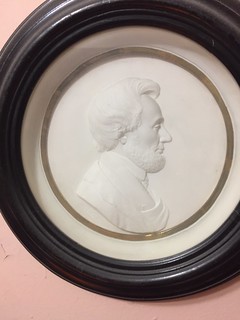
About UsThe Numismatic Bibliomania Society is a non-profit association devoted to the study and enjoyment of numismatic literature. For more information please see our web site at coinbooks.org SubscriptionsThose wishing to become new E-Sylum subscribers (or wishing to Unsubscribe) can go to the following web page link MembershipThere is a membership application available on the web site Membership Application To join, print the application and return it with your check to the address printed on the application. Print/Digital membership is $40 to addresses in the U.S., and $60 elsewhere. A digital-only membership is available for $25. For those without web access, write to: Charles Heck, Treasurer
AsylumFor Asylum mailing address changes and other membership questions, contact Terry at this email address: terrywhite5475@yahoo.com SubmissionsTo submit items for publication in The E-Sylum, write to the Editor at this address: whomren@gmail.com BUY THE BOOK BEFORE THE COIN |
- WAYNE'S WORDS: THE E-SYLUM MAY 12, 2019
- NEW BOOK: INTERNATIONAL NICKEL & GOULD PATTERNS
- NEW BOOK: SHIPS, COLONIES & COMMERCE TOKENS
- NEW BOOK: KRUGER'S BLUEBACKS
- NEW BOOK: THE STORY OF SILVER
- BOOK REVIEW: PLEASURE AND PROFIT, 2ND EDITION
- FLORENCE NIGHTINGALE ON OBSOLETE PAPER MONEY
- VIDEO: WOODEN NICKELS AT 2019 CSNS CONVENTION
- 1943 UNITED STATES TYPE COINS FOLDER
- NOTES FROM E-SYLUM READERS: MAY 12, 2019
- UPDATE ON THE WILLIAM BARBER GRAVESITE
- MORE MOTHERHOOD MEDALS
- VOCABULARY TERM: COLORIZE
- JOHN MCALLISTER, JR. (1786-1877)
- TREASURE HUNTER BOB EVANS SPEAKS TO STUDENTS
- CLASSICAL NUMISMATIC GROUP AUCTION 111
- ARCHIVES INTERNATIONAL AUCTION #52 SELECTIONS
- NUMISMATIC NUGGETS: MAY 12, 2019
- LINCOLNSHIRE 4TH CENTURY ROMAN COIN HOARD
- ANGLO-SAXON TOMB YIELDS COINS
- AUSTRALIAN COIN FIND COULD BE FROM AFRICA
- HOW MEDIEVAL AFRICANS PURIFIED GOLD FOR COINS
- DOUG WINTER REVIEWS FAIRMONT COLLECTION GOLD
- ON THE 1964 SPECIAL MINT SET
- HAWKING JOKE FOOLS COIN COLLECTOR
- UAE COINS MARK OPENING OF SHARJAH MOSQUE
- 2019 AMERICAN MEDAL OF THE YEAR: BREAKOUT
- THERESIENSTADT GHETTO CURRENCY DONATED
- TYPO DISCOVERED IN AUSTRALIAN BANKNOTE DESIGN
- MONEY DIGGING ON MARTHA'S VINEYARD
- LADY BURGLAR AND HER MYSTERIOUS TRUNK
- LOOSE CHANGE: MAY 12, 2019
- PAPER MONEY QUILT
- FEATURED WEB PAGE: WATERLOW BOOK
Click here to access the complete archive a
Click here to unsubscribe (scroll down)
To comment or submit articles, reply to whomren@gmail.com
Content presented in The E-Sylum is not necessarily researched or independently fact-checked, and views expressed do not necessarily represent those of the Numismatic Bibliomania Society.
WAYNE'S WORDS: THE E-SYLUM MAY 12, 2019
 New subscribers this week include: Rick Lank of Hagerstown, MD, and, Jeff Rosenfeld. Welcome aboard! We now have 5,923 subscribers.
New subscribers this week include: Rick Lank of Hagerstown, MD, and, Jeff Rosenfeld. Welcome aboard! We now have 5,923 subscribers.
Thank you for reading The E-Sylum. If you enjoy it, please send me the email addresses of friends you think may enjoy it as well and I'll send them a subscription (but let me know if they are located in the European Union). Contact me at whomren@gmail.com anytime regarding your subscription, or questions, comments or suggestions about our content.
This week we open with FOUR new books, one review, reports from the Newman Numismatic Portal, and several notes from E-Sylum readers.
Other topics this week include Mother's Day, William Barber, John McAllister, Jr., Fairmont Collection gold, the American Medal of the Year, Ghetto currency, a banknote typo, sintered titanium coins, and the paper money quilt.
To learn more about 1960s-1970s era coinage patterns, the Ships, Colonies & Commerce tokens, Florence Nightingale on paper money, wooden nickels, the Eureka Money Manual, the Kamarina Tetradrachm, the Knickerbocker Bank, America's holey dollar, the 1964 Special Mint Set, and the Bank of Pippa Pig, read on. Have a great week, everyone!
Wayne Homren
Editor, The E-Sylum
NEW BOOK: INTERNATIONAL NICKEL & GOULD PATTERNS
A new book by researcher Roger Burdette has been announced. The topic is the rare 1960s-1970s era coinage patterns produced on contract for the U.S. Mint by manufacturers International Nickel and Gould Incorporated. Here's the press release. -Editor
 Seneca Mill Press LLC has released the latest numismatic research book by Roger W. Burdette: Private Pattern and Related Pieces:
International Nickel & Gould Incorporated.
Seneca Mill Press LLC has released the latest numismatic research book by Roger W. Burdette: Private Pattern and Related Pieces:
International Nickel & Gould Incorporated.
This full color volume contains in-depth research on all known varieties of private pattern piece made by International Nickel Corp. (Inco) and Gould, Inc.
The private patterns are placed within their historical context and the commercial goals of both companies. Inco, by addressing the replacement of silver coinage in the United States from 1964-65, sought to increase the amount of nickel used in our coinage. Gould, Inc. proposed changing to powdered metal technology in 1976-78 and advocated use of compressed and sintered titanium in small size dollar coins. Although neither company was successful, they left a fascinating legacy of design, alloy and layered composition test pieces similar in size to standard U.S. coins.
Numismatist Tom Delorey was the first to write about Inco private pattern pieces in 1981. Former Inco employee Kenn Henderson followed with several articles in 1985 – more than 30 years ago. Andrew Pollock followed with updated and numbered varieties in his 1994 book United States Patterns and Related Issues. Pollock also added private patterns made in 1976-78 by Gould, Inc. for a proposed small-size dollar coin.
This new volume fills in numerous omissions and discrepancies in the original Pollock publication, and greatly expands the variety listings. Extensive concordance tables cross reference Pollock variety numbers with new, more extensive "RB" numbers. The new variety numbering also has wide intervals between items so that new discoveries may be added without disturbing the existing sequence. This will aid in establishing the correct variety description, while facilitating improved variety identification.
Mr. Burdette's careful documentation, thorough investigation and factual reporting are as educational as they are professional. Readers will understand the importance of the subject, and be afforded a comprehensive reference guide to Inco and Gould patterns previously non-existent. This is the definitive work that supplants and incorporates all earlier efforts. The images are crisp and clear, the charts easy to navigate and the detailed, clearly understandable scientific explanations of material processes will leave the reader with a profound knowledge and few unanswered questions, if any.
Private Pattern and Related Pieces: International Nickel & Gould Incorporated is available from Wizard Coin Supply (www.wizardcoinsupply.com/?). Cover price for the 8-1/2x11-inch, color book is $29.95.
Roger is a meticulous and thoroughly original numismatic researcher. He takes nothing he reads at face value, always digging deeper to locate original contemporary source materials. Roger also scoured the country finding and meeting holders of the material and employees of the companies that made them.
Roger lives in my area, and I have the pleasure of meeting with him at many of my monthly Nummis Nova numismatic social dinners. One evening this week I swung by to meet him on my way home from work to pick up a copy of the book. It's well illustrated, in color, with detailed tables of information on all known types, varieties and metals, together with historical information and Roger's insightful analysis.
Understanding pattern coinage is a key to truly understanding and appreciating the mint's ultimate official products. The patterns themselves are quite important, rare and interesting coins worthy of collector and market attention. This book will solidify their place in the corpus of American numismatics; look for updates to the standard cataloging cataloging schemes for U.S. Pattern coinage and new holdering from the grading services when these now less-mysterious pieces come to market. -Editor
For more information, or to order, see:
Private Pattern and Related
Pieces: International Nickel & Gould Incorporated
(https://www.wizardcoinsupply.com/private-pattern-and-related-pieces-international-nickel-gould-incorporated)

NEW BOOK: SHIPS, COLONIES & COMMERCE TOKENS
Christopher Faulkner has authored a new book on Canada's Ships, Colonies & Commerce Tokens, published by Spink. Congratulations! Here's the announcement. -Editor
 Spink & Son Ltd. (London, UK) has released a new book on Canadian tokens. Entitled Imperial Designs: Canada's Ships, Colonies
& Commerce Tokens, the book is by well known numismatic author and researcher Christopher Faulkner. Its publication is supported by a grant
from the J. Douglas Ferguson Historical Research Foundation. This 450-page book is the first entirely new study of the series in 100 years.
Spink & Son Ltd. (London, UK) has released a new book on Canadian tokens. Entitled Imperial Designs: Canada's Ships, Colonies
& Commerce Tokens, the book is by well known numismatic author and researcher Christopher Faulkner. Its publication is supported by a grant
from the J. Douglas Ferguson Historical Research Foundation. This 450-page book is the first entirely new study of the series in 100 years.
Chapter One explains the historical meaning behind the presence of the ship on the obverse and the familiar legend on the reverse which gives the series its name. The ship symbolized the primary means of transportation which tied the British North American colonies both to one another and to their mother country.
Throughout the nineteenth century, the words "ships, colonies and commerce" had a wide popular appeal and an almost magical authority. As they passed from hand to hand, the tokens not only circulated a store of value (nominally a halfpenny), they also helped to circulate an idea of empire and the primary means by which that idea was secured. The book's first chapter also offers an account of where and by whom the varieties in the series were struck, and when and where the token circulated in the course of its forty-year life. Earlier efforts at cataloguing the series are explained and there is a detailed record of 12 major collections of the past.
Chapter Two is a fully illustrated catalogue of all known varieties and die states of Breton 997, one of the most difficult and challenging series in Canadian numismatics. For ease of identification the series has been broken down into Groups and sub-groups. Within each Group, every variety and die state receives its own catalogue entry. A number of previously unknown varieties are listed. Every entry includes a commentary which explains the characteristics of the variety and its die states. A sales record, where one exists, accompanies each entry.


Chapter Three deals at length with three extremely rare and controversial Ships, Colonies & Commerce tokens, Breton 999, 1000, and 1001. Every known example of each of these tokens is illustrated and pedigreed. Biographies of W.A.D. Lees and L.A. Langstroth, two of the foundational collectors and cataloguers of the series constitute Chapter Four. Finally, an Appendix deals with various errors in the series and what they can tell us about the circumstances under which the tokens were struck. This book offers the kind of presentation and analysis that have never been undertaken previously with any individual series of pre- Confederation Canadian tokens.
The book was released at Toronto Coin Expo, May 3-4, 2019. It can be purchased in the UK and Europe from www.spinkbooks.com and in Canada from Sveto Kovacevic at Ancient Numismatic Enterprise, 2219 Queen Street E., Toronto M4E 1E8. Email: ane@vcoins.com. Tel. 416 686-8019.
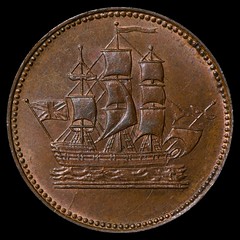
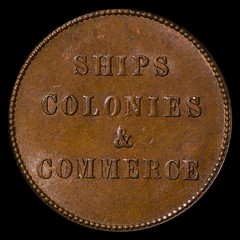
Breton 997
Christopher Faulkner is the author of two previous books from Spink, the award winning The Holey Dollars and Dumps of Prince Edward Island (2012) and Coins Are Like Songs: The Upper Canada Coppers, 1815-1841 (2016).
For more information, or to order, see:
Imperial Designs: Canada's Ships, Colonies and Commerce
Tokens by Christopher Faulkner (https://spinkbooks.com/index.php?route=product/product&path=59/&product_id=631)
NEW BOOK: KRUGER'S BLUEBACKS
Thanks to Pam West for letting me know about this new book by Everhard Vissers on the emergency paper money of the Anglo Boer War. -Editor
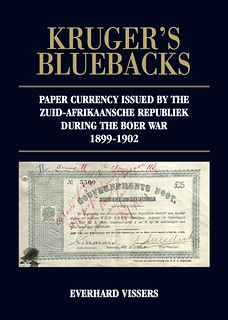 The Anglo Boer War (1899-1902) pitted two small Southern African republics, the Orange Free State and the Transvaal, against the armies of
the largest Empire in the history of mankind. During this conflict Paul Kruger, the Transvaal President, resorted to the issue of emergency paper
money (Gouvernement's Noten or Bluebacks) in an effort to protect his country's dwindling gold reserves. Produced in relatively small quantities and
using anything from notebook pages to newsprint paper, most of the Gouvernement's Noten have been lost over the years and some Noot varieties are now
as rare as a pregnant Panda.
The Anglo Boer War (1899-1902) pitted two small Southern African republics, the Orange Free State and the Transvaal, against the armies of
the largest Empire in the history of mankind. During this conflict Paul Kruger, the Transvaal President, resorted to the issue of emergency paper
money (Gouvernement's Noten or Bluebacks) in an effort to protect his country's dwindling gold reserves. Produced in relatively small quantities and
using anything from notebook pages to newsprint paper, most of the Gouvernement's Noten have been lost over the years and some Noot varieties are now
as rare as a pregnant Panda.
Kruger's Bluebacks is the result of more than a decade of research and archival diggings. The book trails the Gouvernement's Noten from inception to demonetization, contains a wealth of new information and challenges much that was previously written about the subject. Illustrated with hundreds of pictures, tables and graphs, with up-to-date pricing guidelines, Kruger's Bluebacks is an essential reference tool for collectors and dealers alike.


About the author: Everhard Vissers (Dutch, 1957) is a collector of Boer War memorabilia with a focus on original Boer paperwork and Gouvernement's Noten. Mr. Vissers interest in the subject came about during his time spent in South Africa for study and work.
Book information: 290 pages, Printed in an edition of 250 copies on high gloss paper by Monaco Print, Monaco.
Privately published by the author.
Available at Euro 75,- from: info@krugersbluebacks.com , Randcoin in South Africa and Colin Narbeth & Son in the United Kingdom.
To order from Colin Narbeth & Son, see:
Kruger's Bluebacks- new
book by Everhard Vissers. post paid only
(https://colin-narbeth.com/products/kruger-s-bluebacks-new-book-by-everhard-vissers-in-shop-60-uk-post-paid-only)

NEW BOOK: THE STORY OF SILVER
Martin Kaplan forwarded this article interviewing the author of a new book on silver. Thanks. -Editor
 Silver may play second fiddle to gold, its flashier, more expensive cousin. But the white metal has commanded a leading role in shaping the
world's economies from ancient Egypt to modern America. It was mandated as legal tender in the United States in 1789 as part of the Constitution, and
the first mint was in Philadelphia. It was also an element of military conflict, which helped Japan become a global power before World War II.
Silver may play second fiddle to gold, its flashier, more expensive cousin. But the white metal has commanded a leading role in shaping the
world's economies from ancient Egypt to modern America. It was mandated as legal tender in the United States in 1789 as part of the Constitution, and
the first mint was in Philadelphia. It was also an element of military conflict, which helped Japan become a global power before World War II.
William Silber, professor of finance and economics at New York University's Stern School of Business, is the author of The Story of Silver: How the White Metal Has Shaped America and the Modern World. He visited with the Knowledge@Wharton radio show on SiriusXM to talk about silver's enduring importance. (Listen to the podcast at the top of this page.)
An edited transcript of the conversation follows.
Knowledge@Wharton: Silver was designated as U.S. legal tender in 1789, but how far back is its transactional history?
William Silber: Silver was the main unit of money going back 5,000 years. In fact, if you go back to biblical Egypt, it was silver that was used in transactions. There wasn't enough gold to be used by most people, so silver for thousands of years was the main medium of exchange. Only in the 19th century did we switch over to the gold standard. Britain led the world in that. But silver had been the main currency of the world for thousands of years.
Knowledge@Wharton: Do people see its value as important or close to gold, even today?
Silber: Certainly. People look to precious metals, especially during periods of catastrophe or potential catastrophe. Go back to the great inflation in the 1970s, the Great Recession — both gold and silver were bought by many people. In fact, silver responded to those events twice as much as gold. It has been a source of protection, if you want, insurance against declines in other assets.
Knowledge@Wharton: Can you tell us more about the Coinage Act of 1873 and how we came to have this reliance on gold as the value standard?
Silber: Before I get to 1873, let me start with Alexander Hamilton. He established the U.S. dollar, in terms of both gold and silver. He worried about having gold only because it was too scarce. There wasn't enough of it to support a growing economy. You would need a lot of money in order to just grease the wheels of transactions, so he established both gold and silver because gold was too scarce.
We had discoveries of gold in the United States, but also in Australia and in Russia. And suddenly gold became much more plentiful. That's what led the world, as a whole, to begin to adopt the gold standard. In 1873, the United States passed a law that eliminated the silver dollar as currency. It was called The Crime of 1873 primarily by western mining states that did not like the fact that silver was no longer part of the U.S. monetary system.
To read the complete article, see:
White Hot: How Silver Forged the World's Economy
(https://knowledge.wharton.upenn.edu/article/the-story-of-silver-book/)
BOOK REVIEW: PLEASURE AND PROFIT, 2ND EDITION
Michael Marotta submitted this review of the 2nd edition of Robert Shippee's Pleasure & Profit book. Thanks! -Editor
 Pleasure & Profit (Second Edition): 100 Lessons for Building and Selling a Collection of Rare Coins by Robert W. Shippee,
Whitman, 2019, 318 +x pages, $19.95.
Pleasure & Profit (Second Edition): 100 Lessons for Building and Selling a Collection of Rare Coins by Robert W. Shippee,
Whitman, 2019, 318 +x pages, $19.95.
Robert W. Shippee found no profits and significant losses in his acquisitions of high-grade certified modern coins. A Deep Cameo Proof 69 Silver 1999-S Connecticut Quarter is just not rare; and it simply never excited him. He bought the coin (and four more similar Mint States and Proof, silver and clad 1965, 1976, 1999) and he lost half of his $370 investment at sale. He bought them only to complete a PCGS Registry set. He built the set only to sell it. He made a lot of money on the truly collectible and objectively rare coins from the 18th, 19th, and 20th centuries, and he did it under ten years. This is his story.
He weaves numismatics with his other passion, golf. My complete disinterest in golf did not detract from the book. And I am not an investor. As a numismatist, I write history. Whether I (or you) could afford any of these coins is also putative, but well worth considering. Shippee was an international banker. He could well afford to golf at the finest courses. So, to pay $3220 for an 1869 DDO Proof 66 Cameo Nickel 5-Cent coin was not beyond his budget. (He sold it two-and-a-half years later for $4140, a gain of 29%.)
But if you stop and think about it, it might not be beyond ours, either. I mean, how much do we all spend on low grade and midrange stuff every week, whether online or at the coin store? What if you bought only one or two coins a year? What would you have at the end of ten or 20 years? Would you sell for a loss over the counter at a coin store or would your inventory be given a name in a catalog?
For each entry, Shippee details the financials: cost; sale price; gain or loss; and holding period. But the book offers far more than mere gloating over the wins and polite coughs over the losses. The history of each coin also is given in a couple of paragraphs or a couple of pages, often with the nice textual details paralleling the visual appeal of the subject.
"The Draped Bust, Large (or Heraldic) Eagle half dime, designed by Robert Scot, was minted in five years from 1800 to 1805, with a break in production in 1804. Fewer than 125,00 coins of this design were produced, so all dates are scarce today. In 1803, mintage was a puny 3,060 pieces, making this date a classic rarity. Only about 15 examples reside in major grading service holders, and none of these grade better than AU-50. On the rare occasion when one comes up for auction, you should not be surprised to see a six-figure price. Counterfeit examples of the 1802 dime exist, and both the Smithsonian and American Numismatic Association have one of these in their institutional collections. Of the other four dates, the 1800 is clearly the best struck and the most readily available, while the remaining three dates are all about equally scarce."
Cost: $10,000; Sale Price $18,400; Gain 84%; Holding Period 3.2 years.
Whether you have an extra ten grand or not, if you want to invest in rare American coins the principles explained here are valid across the range. And, in fact, I submit that they apply not only to old coins or old books, but to any collectible: buy what other people want; buy the best you can afford; buy rarities; buy what you care about. The last point should not be overlooked.
Just take refrigerators, for example. You could save your money and buy an outstanding machine that begs to be in someone else's home. But if you have no passion for household appliances, you are not likely to find another buyer who is on fire for an icebox. Before the sale of his "Waccabuc Collection" Shippee knew other collectors and was known. He was a regular at ANA conventions. He visited dealers when he traveled. He corresponded. He bid and bought. He participated in our hobby. His passion for the game was the key to his success.
To read the earlier E-Sylum articles, see:
NEW BOOK: PLEASURE AND PROFIT, 2ND EDITION
(https://www.coinbooks.org/v22/esylum_v22n08a04.html)
BOOKMAKING: PLEASURE AND PROFIT
(https://www.coinbooks.org/v22/esylum_v22n13a04.html)
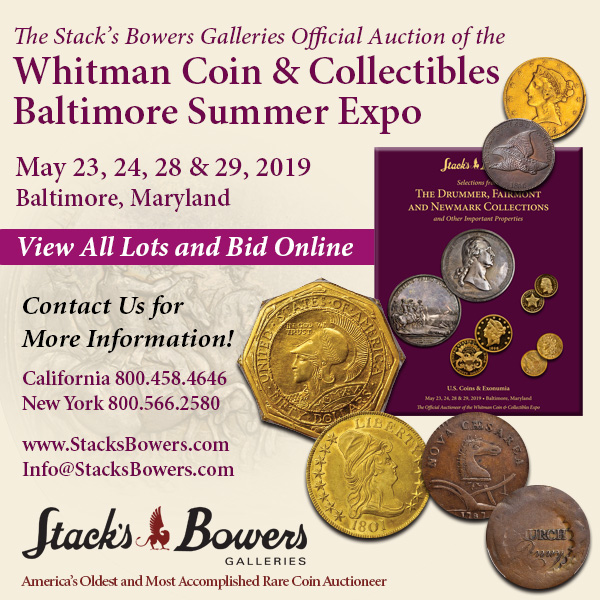
FLORENCE NIGHTINGALE ON OBSOLETE PAPER MONEY
Newman Numismatic Portal Project Coordinator Len Augsburger provided the following note on Florence Nightingale on obsolete paper money. Thanks. -Editor

Western Bank of Missouri $2 (1861)
May 12 is International Nurses Day and marks the 199th anniversary of Florence Nightingale's birth. Nightingale is the founder of modern nursing and today acknowledged for elevating the occupation to a professional level. British by birth, she rose to prominence through her medical service during the Crimean War (1853-1856). Among her greatest contributions was the use of statistical methods as a tool to manage public health. It is no surprise that Nightingale has been the subject of engravers ever since, such as this $2 Western Bank of Missouri note from the Eric P. Newman collection.
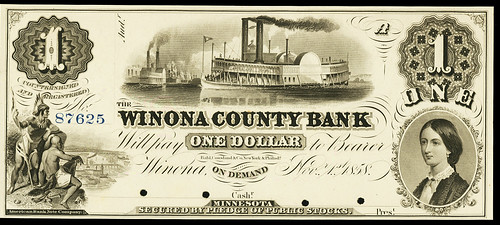
Winona (MN) County Bank $1 (1858)
A second example comes from Minnesota, a Winona County Bank $1 from 1858. A final example reminds us of the ever present paper money counterfeiters, this an 1859 $20 counterfeit note from the Farmers Bank of Missouri. The last was acquired by Newman from D.C. Wismer, the dealer who tipped off Newman to the existence of Missouri paper money in the Col. Green estate – Newman followed up with Chase Bank (the estate administrator) in New York, and the rest is history. The particular note sold for only $132, a lot of provenance for a little currency.
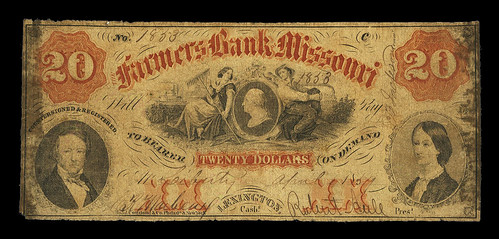
Farmer Bank of (Liberty) Missouri $20 (1859)
Images:
Western Bank of Missouri $2 (1861), from Newman VII (Heritage Auctions, 10/2015, realized $6,462.50).
Winona (MN) County Bank $1 (1858), from Newman VII (Heritage Auctions, 10/2015, realized $2,115).
Farmers Bank of (Liberty) Missouri $20 (1859), counterfeit, from Newman VIII (Heritage Auctions, 11/2017, realized $132).
Heritage Auctions on NNP:
https://nnp.wustl.edu/library/auctioncompanydetail/8
VIDEO: WOODEN NICKELS AT 2019 CSNS CONVENTION
These are selections from the David Lisot Video Library that feature news and personalities from the world of coin collecting. David has been attending coin conventions since 1972 and began videotaping in 1985. In 2017 the Newman Numismatic Portal reached an agreement to list all David's videos on their website. Each week an excerpt of a different video is available on the CoinTelevision YouTube channel.
Here's one on Wooden Nickels at 2019 CSNS Convention. -Editor
 Darrell Luedtke, Past-President, International Organization of Wooden Money Collectors, David Lisot, Interviewer, CoinTelevison.com. See
and learn how the Great Depression caused the creation of an innovative and clever form of money to purchase items. Find out why the expression,
"don't take a wooden nickel" came about. And see examples of some cool wooden nickels!
Darrell Luedtke, Past-President, International Organization of Wooden Money Collectors, David Lisot, Interviewer, CoinTelevison.com. See
and learn how the Great Depression caused the creation of an innovative and clever form of money to purchase items. Find out why the expression,
"don't take a wooden nickel" came about. And see examples of some cool wooden nickels!
This video is a highlight from the Central States Numismatic Society Convention held May 24-27 that will be available in its entirety on the
Newman Numismatic Portal at
https://nnp.wustl.edu/library/multimediadetail/522852
An excerpt of the video is available for viewing on the Coin Television YouTube Channel at:
https://youtu.be/Rt5JiptQb6c
Cool Coins, Currency, & Collectibles! Wooden Nickels at CSNS Convention
VIDEO: 9:53

1943 UNITED STATES TYPE COINS FOLDER
Dave Lange submitted these notes on a rare U.S. Type Coins folder. Thanks. -Editor
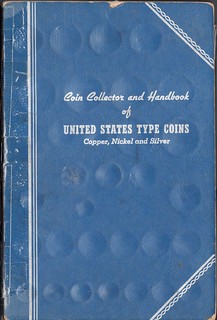 The passing of Sol Taylor was very sad news to me. We got to know each other while I was researching and writing The Complete Guide to
Lincoln Cents. This coin series was, of course, his very favorite, and he devoted most of his numismatic time and study to it. My book was
something of a rival to his, but we nonetheless worked together on many topics relating to Lincoln Cents.
The passing of Sol Taylor was very sad news to me. We got to know each other while I was researching and writing The Complete Guide to
Lincoln Cents. This coin series was, of course, his very favorite, and he devoted most of his numismatic time and study to it. My book was
something of a rival to his, but we nonetheless worked together on many topics relating to Lincoln Cents.
Sol also knew of my passion for old coin boards, folders and albums. When it came time for him to begin downsizing his own collections he sent me a U. S. type coin folder that he'd owned since it was new in 1943. Well worn and somewhat damaged, it's the least attractive of the several examples I own, but I've cherished it for the memories it held for him and for my own memories of him. I'm attaching a couple of photos that show this folder.
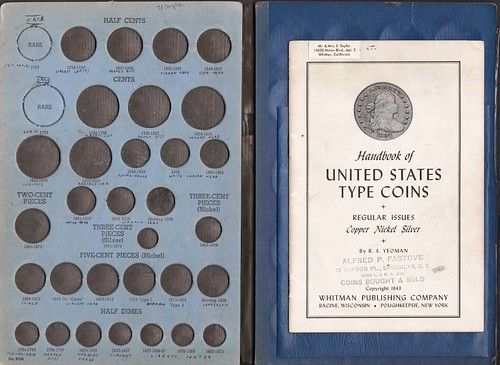
Produced only once during 1943, this oversize folder was later split into two parts and published in the small format typical of Whitman blue folders to the present day. It's quite a rare item, and I've cataloged it for my upcoming book on Whitman folders and albums. An image is attached of that book entry.

To read the earlier E-Sylum article, see:
DR. SOL TAYLOR (1931-2019)
(https://www.coinbooks.org/v22/esylum_v22n17a06.html)
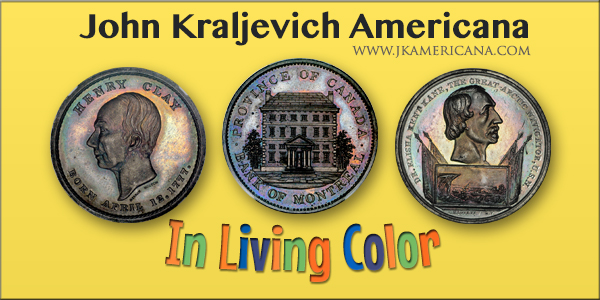
NOTES FROM E-SYLUM READERS: MAY 12, 2019
Information Sought on Magician Professor King

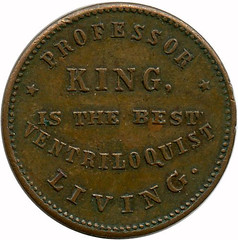
Regarding an item illustrated in my Numismatic Nuggets article last week, Jud Petrie writes:
As an avid magic token collector and researcher I would like to add some more information on it and ask for any information about the issuer, as none has been found. The Society of American Magicians (of which I am also a member) has no record of him.
Many years ago anyone who could do something that the ordinary person couldn't do was considered to be using magic. This included juggling, shadowography (making silhouettes using their hands), contortionism, ventriloquism, even to performing Punch and Judy shows etc.?
The token is listed as MT196 in Kuethe's reference Magicians' Tokens and Related Items, and was issued in both copper (R-5) and brass (R-6). Notable is the incorrect spelling of Samson, adding a 'P'.?
Can anyone help? These are a great numismatic specialty, with a fun mystery to be solved - just who was Professor King? -Editor
To read the earlier E-Sylum article, see:
NUMISMATIC NUGGETS: MAY 5, 2019 : 1875 King Ventriloquist Token
(https://www.coinbooks.org/v22/esylum_v22n18a26.html)
Abraham Lincoln Cameo
 Alan Weinberg writes:
Alan Weinberg writes:
Related to last week's E-Sylum article on the Mint engraver Salathiel Ellis engraved cameos, I own a splendid high relief 2/3rds face forward Abraham Lincoln cameo, 67.5 x 57 mm in gold frame hinged pin which was a prized item in Norman Stack's personal collection for decades - he showed it to me when I was a kid.
It is pictured in color on the center cover of Stack's Philadelphia Americana sale Sep 23-26, 2009 and in color as lot 7739 "From the Stack Family Collection". I bought it for $17K.
Great piece of work! I found the image via the Newman Numismatic Portal. -Editor
To read the earlier E-Sylum article, see:
POLK CAMEO BY SALATHIEL ELLIS
(https://www.coinbooks.org/v22/esylum_v22n18a14.html)
To read the catalog entry on the Newman Portal, see:
The Philadelphia Americana Sale, Part Two
(https://nnp.wustl.edu/library/auctionlots?AucCoId=3&AuctionId=517018)
Tony Terranova passed along this image of a plaster model for an Indian peace medal by Salathiel Ellis. Thanks. -Editor
To read the earlier E-Sylum article, see:
POLK CAMEO BY SALATHIEL ELLIS
(https://www.coinbooks.org/v22/esylum_v22n18a14.html)
Eureka Money Manual
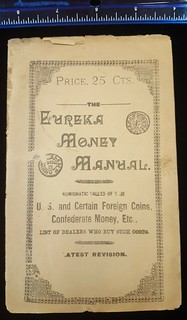 Sean Moffatt writes:
Sean Moffatt writes:
I think your readers might be interested so I would like to announce that I have placed a Eureka Money Manual on eBay. The link is below. This is a coin price list issued by C.F. Clarke of Le Roy, NY, and according to information I found in the Newman Numismatic Portal it was issued in 1895. I found it in a lot of vintage coin books I purchased at an estate sale.
Thanks - these coin guides are fun to collect. -Editor
To view the complete lot description, see:
Eureka Money manual coin price guide, published 1895 by CF Clarke & Co
(https://www.ebay.com/itm/223506899636)
16 Maravedis Coin Found in Utah

Regarding the old coins found in Utah, David Yoon writes:
There is actually a small mystery there. The coin on the right is a 16 maravedis, minted in the 1660s in Madrid. Not a common find, especially in an area that didn’t have Spanish settlement in the late 1600s, but not entirely impossible. The coin on the left, although they didn’t show the more distinctive side, appears to be a dinero of Alfonso X of Castile, from the mid-1200s. Definitely not in circulation in the colonial period. That one must have been brought to the region by a collector, either modern or colonial, and the 1660s coin might be explained that way as well.
To read the earlier E-Sylum article, see:
UTAH SPANISH COIN FIND PUZZLES PARK SERVICE
(https://www.coinbooks.org/v22/esylum_v22n17a23.html)
Dick Hanscom and George Kolbe forwarded a Daily Mail article on the topic. Thanks, everyone. George adds: "Wouldn’t it be fun, and good PR, for coin collectors to ‘salt’ various old coins in unlikely locales?" -Editor
To read the Daily Mail article, see:
Mystery of the Spanish
coins that predate Christopher Columbus by 200 years and have been found deep in the Utah desert
(https://www.dailymail.co.uk/news/article-7009641/Mystery-Spanish-coins-Utah-desert-predate-Columbus-200-years.html)
Bank of Pippa Pig Note
Phil Iversen writes:
This was sent to me by another collector and I thought it appropriate to use and fool somebody with as this is the Chinese calendar "Year of the Pig."

Read A Book!
For Mother's Day Dick Johnson submitted this cartoon. Thanks. Listen to your Mom and pick up a great (numismatic) book. -Editor
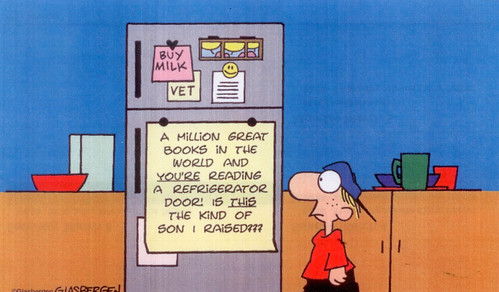
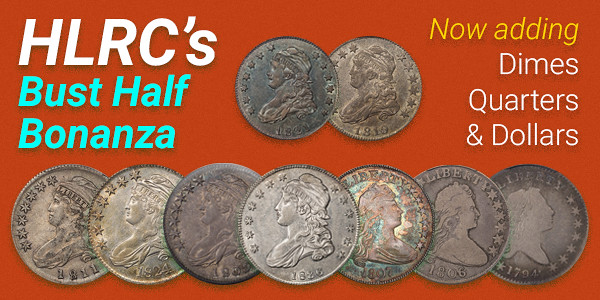
UPDATE ON THE WILLIAM BARBER GRAVESITE
John Frost submitted this encouraging update on the William Barber gravesite. Thanks! -Editor
Following the discovery of the first-known photo of Chief Engraver William Barber in late February, I was happy to see a lot of excitement in the collecting community about the photo and the 5th Chief Engraver himself. One of my favorites was the write-up from Heath MacAlpine about his visit to William Barber’s gravesite in 2012, along with those of several other mint engravers, as described in the March 17 edition of The E-Sylum.
When I was in the midst of discovery of all of the new information on both William and Charles Barber (after meeting their descendants and having the privilege of examining all of their historic documents and amazing artifacts), I developed a greater level of appreciation of both Barbers, as men. One of the things I also did last year was to seek out and discover their gravesites.
Like Heath had mentioned, while researching William Barber’s final resting place, I was disheartened to hear of the fate of Mount Moriah Cemetery in Philadelphia. I actually found and watched a short YouTube video of Heath from his 2012 visit (https://www.youtube.com/watch?v=r8_p0Bt2PyQ), showing the overgrown cemetery, and the generally poor shape of the area of William Barber’s gravesite. However, according to the Facebook page of the volunteer group, Friends of Mount Moriah Cemetery, it looked like these tireless volunteers were working hard to restore and maintain the cemetery, one section at a time.
I used Find-a-Grave and located the section of the cemetery where William Barber and his wife and two daughters reside, and using Google Maps, I was able to trace a route through the vast cemetery to the correct section. Happily, last year, I found this section is restored and maintained now, and I found William and his wife, Anna Maria, quite easily. I brought three other members of the Liberty Seated Collectors Club (LSCC) and Barber Coin Collectors’ Society (BCCS) to pay our respects to William Barber. I have since updated the Find-a-Grave listing of William Barber to include the newly-discovered photos of him and his wife, Anna Maria.

Section 140 of Mount Moriah Cemetery, with William Barber’s gravesite marked

LSCC/BCCS members visit the gravesite of William Barber
Later that day, we ventured to Charles Barber’s final resting place, a little north of town in Mount Peace Cemetery, still active and fully maintained. The cemetery staff was very helpful and actually drove us out to Charles’ gravesite, just off one of the side roads.
Detailed maps to the gravesites of Christian Gobrecht and William Barber can be found on the website of the Liberty Seated Collector’s Club (www.lsccweb.org), and specifically the pages www.lsccweb.org/ChristianGobrecht.shtml and www.lsccweb.org/WilliamBarber.shtml.
A detailed map to the gravesite of Charles E. Barber can be found on the website of the Barber Coin Collectors’ Society (www.barbercoins.org), specifically the page, www.barbercoins.org/CharlesBarber.shtml).
To read the earlier E-Sylum article, see:
THE WILLIAM BARBER GRAVESITE
(https://www.coinbooks.org/v22/esylum_v22n11a13.html)

MORE MOTHERHOOD MEDALS
Dick Grinolds submitted these Mother-themed medals. Thanks. Happy Mother's Day, Moms! -Editor
I noticed the brief mention of Mother's Day in the May 5, 2019 E-Sylum -- here are a couple of medals close to or spot on the subject.


1. Motherhood -- Victor David Brenner's contribution to the first private collector medal series in America, The Circle Of Friends Of The Medallion, Issue #4 struck by Joseph K. Davison & Son of Philadelphia.
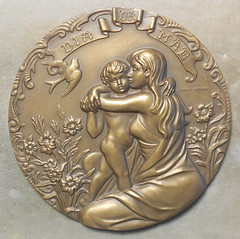

2. Mother's Day (Dia Da Mae in Portuguese) -- a huge 99mm bronze medal by Cabral Antunes with a mother and child on the obverse and a verse on the reverse which does not Google translate very well.
Of course here in The Land Of 10,000 Lakes, Mother's Day is also known as "the day after fishing opener...".
To read the earlier E-Sylum article, see:
NOTES FROM E-SYLUM READERS: MAY 5, 2019 : Russian Mother's Medal
(https://www.coinbooks.org/v22/esylum_v22n18a12.html)
VOCABULARY TERM: COLORIZE
Dick Johnson submitted this entry from his Encyclopedia of Coin and Medal Terminology. Thanks. -Editor
Colorize. Coating by colored pigments. There are three ways to add color to metal as a medallic (or numismatic) item. The oldest method, and with the most successful application of color, is with enamel. A second method is with a patina finish (where metal surfaces are chemically altered). The third method is coating with a pigment on the metal's surface. The first two are not colorizing, the third method is called colorized.
Colorizing is, in effect, painting an object. organic coating, as most paints, have been tried in the past and rejected. Painting numismatic objects is unsatisfactory because of the tendency of any coating to chip on the high points and near the edges of a coin or medal. More recently acrylic coatings have been employed, as they meet the requirements of adhering to the metal surface with a fairly thin coating.
Since metals in which numismatic items are made are one color, monochrome, the preferred method, of course, is a patina finish on the metal surface, which is not only permanent but also impervious to chipping. Or color may be added by enamel, enamelling, as evidenced by orders and decorations. Metal objects can also be plated but this is replacing one metal color for another.
Colorized Coins. A fad created in the 1990s was to colorize coins and medals. This appealed to the public more so than collectors or numismatists and met with some acceptance.
Colorized medallic items. An example of painted medallic items are the Iron Cross of Germany in the lower grades. These were painted black and after some use it is easy to observe that the black paint chips away exposing the under metal. (Higher grades of the Iron Cross use black enamel, which of course, does not damage so easily.)
The Fairmont Park Act Association Medal of Honor, 1937, was issued with a black paint finish; since it is not intended to be worn it is less susceptible to wear but has been observed with a chipped coating. Other examples are painted plaques and plates made by medallic companies, one example of each are the Theodore Roosevelt Plaque painted brown (see illustration under quotation) and a Panda Plate made by Medallic Art Company painted black and white.
Looking for the meaning of a numismatic word, or the description of a term? Try the Newman Numismatic Portal's Numismatic Dictionary at: https://nnp.wustl.edu/library/dictionary
Or if you would like a printed copy of the complete Encyclopedia, it is available. There are 1,854 terms, on 678 pages, in The Encyclopedia of Coin and Medal Technology. Even running two a week would require more than 19 years to publish them all. If you would like an advance draft of this vital reference work it may be obtained from the author for your check of $50 sent postpaid. Dick Johnson, 139 Thompson Drive, Torrington, CT 06790.

JOHN MCALLISTER, JR. (1786-1877)
 John McAllister, Jr. (1786-1877), was born on June 29, 1786, at the northwest corner of Second and Market Streets, Philadelphia,
Pennsylvania, son of John McAllister Sr. (1753-1830), a Scottish immigrant and manufacturer of canes and whips, and Frances Wardale Lieber
(1746-1814).
John McAllister, Jr. (1786-1877), was born on June 29, 1786, at the northwest corner of Second and Market Streets, Philadelphia,
Pennsylvania, son of John McAllister Sr. (1753-1830), a Scottish immigrant and manufacturer of canes and whips, and Frances Wardale Lieber
(1746-1814).
In spite of Herkowitz's 1996 mischaracterization of John McAllister, Jr., as "anonymous in Philadelphia society" the McAllister family and McAllister Company remained very prominent in Philadelphia society for about 125 years as businessmen, manufacturers, and collectors. There are three generations of John McAllisters, who were antiquarians and collectors. This biography focuses on only the first two.
The American paterfamilias : John McAllister Sr. (1753-1830), arrived in America in 1775 from Scotland. In 1781, he established a turner shop on Market Street, between Front and Second Streets, Philadelphia manufacturing whips and canes. In 1790, McAllister assisted in publishing the advertisement for the Manly Medal in Carey's Magazine for April 1790. Perhaps McAllister also assisted in the notice cited by Lupia, American Numismatic Auctions, published in Dunlap's American Advertiser, Monday, December 22, 1794. In 1796, he bought on speculation a quantity of spectacles selling them as a sideline...
By 1830, the McAllister family became the dominant Philadelphian manufacturer and proprietor of optical equipment and instruments. After the death of John McAllister, Sr., May 12, 1830, John McAllister, Jr., with Walter B. Dick, et alia, carried on the business under the firm name of John McAllister, Jr., & Co. Six years later, in 1836, John McAllister, Jr., retired leaving the company to his son William Young McAllister who renamed it William Y. McAllister & Co.
John McAllister, Jr., was educated in Philadelphia, and graduated at the University of Pennsylvania in 1803. He had been for many years the oldest surviving alumnus of that institution prior to his own death in 1877. He was an avid antiquarian of local Philadelphia history and particularly in local antiquities. He was very close to other antiquarians of Philadelphia such as John Vaughan Merrick who presented him with a gift of 15 (fifteen) of the 16 different Continental bank notes that at that time were believed to comprise them in their entirety.


Above : Bifolia 4 page undated letter (circa 1855 - 1860) from J. Vaughan Merrick to John McAllister, Jr. sending him 15 of the 16 known varieties of Continental Paper Money issued. The reverse side opens up to two pages one of which contains the full list of Continental Notes presented as gifts together with their denominations, serial numbers, dates of issue Resolution of Congress, and names of signers. This feature of the letter provides these notes with provenance dating back to Merrick and McAllister. An exceptional piece of American numismatic history especially for Colonial paper money collectors. Courtesy Lupia Numismatic Library. Unique.
On his 25th birthday, June 29, 1811, at Rockland, New Castle County, Delaware, he married Eliza Melville Young (1790-1853), the daughter of William Young (1755-1829), a Philadelphia printer, bookseller, and the original publisher of the Columbian Magazine. They had ten children...
During his retirement John McAllister, Jr., devoted his time to antiquarian research on Philadelphia including his investigations of the United States Mint, Colonial coinage, particularly Washington cents since he is noted having a 1791 specimen, and of course, Continental Currency. His notes from the 1840's are frequently cited by modern day numismatists since it is the origin of the claim that George Washington deposited the silver to mint the first half dismes..
Dave Bowers, American Numismatics Before the Civil War, tells us : "In the 1840's, continuing through the 1850's, numismatist John McAllister was quite interested in the history of the Mint and interviewed Adam Eckfeldt and other officials. Unfortunately he never published his findings." And further on he notes : "1857, October : "Restilla" a nom de plume for John McAllister, a Philadelphia numismatist (who is also a contender as the inventor of the word telegram), told of the 1791 Washington cent and of discussing coinage history with Jonas R. McClintock and Adam Eckfeldt, earlier of the Philadelphia Mint." The pseudonym "Restilla" is a mirror image nom de plume, i.e., McAllister spelled backwards.
McAllister, Sr.'s, fame persisted decades after his death as a great numismatist. As George Fuld (2008) astutely pointed out : "Snowden, in his 1861 catalog, quoted a letter from John McAllister of Philadelphia, who stated he could recollect that "Robert Scot [sic], one of the first engravers of the Mint, had his room in Carter's Alley, next to the corner of Second Street, and it may be that himself, or some engraver in his employ, executed the die."
McAllister, blind and suffering from partial paralysis for two years finally died on December 17, 1877 at his residence at 14 North Merrick Street, Philadelphia. He is buried in Woodlands Cemetery.
To read the complete article, see:
McALLISTER, Jr., JOHN
(https://sites.google.com/a/numismaticmall.com/www/numismaticmall-com/mcallister-jr-john)
The entire inventory of the Lupia Numismatic Library is for sale. Individual items will be available before the remaining archives are broken up into parcels sold at philatelic auctions in the U. S. and Hong Kong. Check NumismaticMall.com frequently as dozens of new items with estimates will be posted daily until everything is sold.
All inquiries will be given prompt and courteous attention. Write to: john@numismaticmall.com .

TREASURE HUNTER BOB EVANS SPEAKS TO STUDENTS
Not all treasure hunters become treasure finders, and few do so in the big way Bob Evans did with the wreck of the SS Central America. In a recent trip to Minnesota Bob spoke to a group of students at Hutchinson middle school. Here's an excerpt from an article in the local Hutchinson Leader newspaper. -Editor
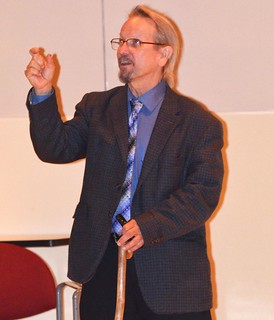 Hutchinson Middle School students received a history lesson of a different sort on Wednesday when Robert Evans, a consulting geologist,
paid a visit to the school.
Hutchinson Middle School students received a history lesson of a different sort on Wednesday when Robert Evans, a consulting geologist,
paid a visit to the school.
Evans had a whale of a tale to tell. He was co-discoverer of the S.S. Central America shipwreck site, a gold-rush era treasure ship. The 280-foot sidewheel steamer ran afoul of a hurricane in September 1857. It sank along with 425 of her 578 passengers and crew, and 30,000 pounds of gold.
As chief scientist and historian for the project, Evans was part of the team that located the wreck, which was found about 150 nautical miles from Cape Fear, North Carolina.
He also served on the recovery team that used state-of-the-art robotic technology to plumb the shipwreck that rested more than a mile deep along the ocean floor. Ultimately, Evans said they recovered one of the "most incredible treasures in American history" — 577 gold bars, more than 10,000 gold coins and more than 10,000 pieces of silver.
Evans’ first visit to Minnesota was the result of a serendipitous meeting. He and Shad Ketcher, owner of New Era Financial Advisors Inc., Hutchinson, served together on a panel at a conference in Dallas, Texas. The two got to talking and one thing led to another. In addition to addressing middle school students, Evans was the featured speaker during an event Wednesday evening at Crow River Golf Club.
Bob adds:
It was fun, in spite of inclement weather. Talking to students is always delightful, and to see their response. Minnesotans are undaunted by 35 degrees with driving wintery mix on May 8. The evening event at the gold club was fairly well packed, with close to two hundred in attendance. Finally, I got to see some part of Minnesota other than the inside of the Minneapolis/St. Paul airport.
And for the record, the figure of "30,000 pounds of gold" did not come from me. This reporter conducted a very pleasant interview, and she was well-schooled in the subject, having done her homework (interesting subject, I guess.) She must have pulled this speculative figure from earlier publications from the nineties. Amazing how stuff lives forever online.
To date, we have recovered more than two tons of gold from the S.S Central America site. I did tell her that.
To read the complete article, see:
Meeting a
treasure hunter
(https://www.crowrivermedia.com/hutchinsonleader/news/local/meeting-a-treasure-hunter/article_e956b515-d931-5854-aecd-8565e1446c45.html)

CLASSICAL NUMISMATIC GROUP AUCTION 111
Here's the announcement for Classical Numismatic Group's Auction 111. Great coins. -Editor
An Internet and Mail Bid Sale
Closing Electronically on Wednesday, 29 May 2019, from 10 AM ET
Classical Numismatic Group is proud to present CNG 111, an Internet and Mail Bid Sale closing electronically on Wednesday, 29 May 2019, from 10 AM ET (U.S.). This sale offers 1168 lots with a presale estimate of $2.75 million.
Our annual spring sale features Greek, Celtic, Oriental Greek, Central Asian, Roman Provincial, Roman Republican, and Roman Imperial coinage. Additionally, there are featured selections of Byzantine, Early Medieval, Islamic, World, United States, and British.
CNG 111 is highlighted by a number of collections and individual rarities, which make up the majority of coins on offer:
- Greek, Roman, Early Medieval, and British Coins from the Ealing Collection
- Further Selections from the Gasvoda Collection
- Pedigreed Carthage Dekadrachm
- The Siren Collection of Early Electrum Coinage
- Continued Offerings from the MNL Collection of Seleukid Coins
- Jewish War Year 4 Shekel
- Further Selections from the Michel Prieur Collection of Syro-Phoenician Silver Coinage
- The Brexit Collection of Roman Gold Coins, including an Aureus of Pertinax and the First Portrait of Commodus in Gold
- Very Rare Procopius Solidus
- Impressive Wu Zhu Mold from the Arthur B. Coole Collection
- Selections from the RAJ Collection of World Medals
- Stunning 1907 Wire Rim Indian Eagle
- Important Early Anglo-Saxon and Norman Coins
- The G.W.K. Roberts Collection of British Milled Coinage
Catalogs for CNG 111 have been mailed to our active mailing list and bidding is open on the site. Some of the individual highlights from CNG 111 are:
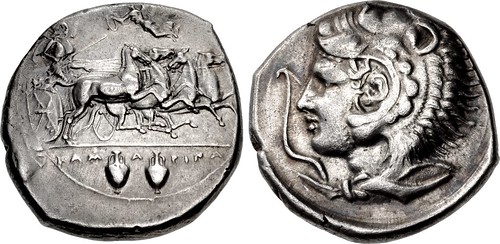
Lot 60–SICILY, Kamarina. Circa 425-405 BC. AR Tetradrachm (26mm, 16.46 g, 7h). Athena, wearing crested Attic helmet and long chiton, holding kentron in right hand and reins in both, driving galloping quadriga right; above, Nike flying left, preparing to crown Athena with wreath held in both hands; in exergue, two amphorai dividing KAM-A-PINA / Beardless head of Herakles left, wearing lion skin headdress tied at neck; bow to left. Westermark & Jenkins 152 (O10/R19); HGC 2, 526; SNG Fitzwilliam 945 (same dies); SNG Stockholm 431 = Pozzi 400 (same dies); Athena Fund I 1 (same dies); BMC 13 (same dies); Gillet 368 = Rizzo pl. V, 15 (same dies); Jameson 525a (same dies); Weber 1246 (same dies). Good VF, toned, a little off center. Estimated at $7,500
Ex Hess-Divo 307 (8 June 2007), lot 1055; Münzen und Medaillen AG 66 (23 October 1984), lot 25.
Nearly 140-year-old Pedigree

Lot 64–SICILY, Leontini. Circa 440-430 BC. AR Tetradrachm (25mm, 17.25 g, 12h). Head of Apollo right, wearing laurel wreath / Head of roaring lion right; LEO-NTIN-ON and four barley grains around. Boehringer, Münzgeschichte 52 var. (lion head left; same obv. die); HGC 2, 669 var. (same; same obv. die as illustration); Weber 1382 (this coin – reverse photo switched with 1381). Good VF, old cabinet tone. Estimated at $5,000
Ex Henry Platt Hall Collection (Part I, Glendining & Co., 19 July 1950), lot 44; Sir Hermann Weber Collection, 1382; Ferdinand Bompois Collection (Hoffman, 16 January 1882), lot 426 (possibly 425: Weber lists 426, but that coin is listed at 16.70 grams, while 425, of the same type, is at a closer weight of 17.20 grams).

Lot 265–IONIA, Uncertain. Circa 600-550 BC. EL Trite – Third Stater (12mm, 4.71 g). Lydo-Milesian standard. Carapace of scarab beetle / Two
incuse squares with geometric designs. Weidauer –; Traité –; SNG Kayhan 673; Linzalone 1110 ("ram", same incuse punches). VF. Extremely rare
denomination for type.
Estimated at $2,000

Lot 382–JUDAEA, Jewish War. 66-70 CE. AR Shekel (22.5mm, 14.12 g, 12h). Jerusalem mint. Dated year 4 (69/70 CE). Omer cup; "Y[ear] 4"
(date) in Hebrew above, "Shekel of Israel" (in Hebrew) around / Sprig of three pomegranates; "Jerusalem the holy" in Hebrew around. Deutsch –
(O–/R25); MCP FJR 10, dies O8/R13; Meshorer 207; Kadman 27; Hendin 1364; Bromberg 72; Shoshana I 20212 = Shoshana II 20124; Sofaer 36; Spaer 178.
Near EF, die flaws on obverse.
Estimated at $15,000
Year 4 shekels are decidedly rarer than those of Years 1-3, reflecting the deteriorating military and political situation of the Judean rebels. While surviving shekels of each of the first three years number in the hundreds, fewer than 50 survive for Year 4. The Jewish forces, increasingly confined to the environs of Jerusalem, were suffering severe shortages of everything from precious metals to foodstuffs, meaning there was far less silver available to strike coins, and very little in the way of goods for them to be spent buying. The dies used for striking coins also show signs of haste in preparation. This specimen appears to have a noticeable metal defect, or "delamination," in the obverse field left of the chalice; however, this same "metal flaw" appears on the only other known specimen struck from this obverse die (sold in Heritage 3005, May 2009, lot 20062), indicating it is a raised area in the die itself. Normally such a die flaw would have been abraded and polished away before striking, but here it was apparently overlooked or not viewed as important enough to correct, all indications of mounting difficulties at the mint.

Lot 734–Commodus. As Caesar, AD 166-177. AV Aureus (20mm, 7.29 g, 5h). Rome mint. Struck under Marcus Aurelius and Lucius Verus, AD 175.
COMMODO CAES AVG FIL GERM, bareheaded, draped, and cuirassed bust right / PR INC • IVVENT, Commodus, wearing military tunic and cloak, standing
left, holding olive branch in right hand and grounded reversed spear in left, trophy of arms to right. RIC III 600 (Aurelius; corr. omits bust
cuirassed); MIR 309-12/17; Calicó 2314 (same obv. die as illustration); BMCRE 637 (Aurelius and Verus; corr. omits bust cuirassed); Biaggi –; Jameson
–; Mazzini –. Near EF, underlying luster. Well struck on a broad flan. Rare.
Estimated at $10,000
From the Brexit Collection. Ex Palombo 16 (21 October 2017), lot 50 (realized 30,000 CHF); Vinchon (30 November 1993), lot 40; Vinchon (23 April 1976), lot 250.

Lot 738–Pertinax. AD 193. AV Aureus (20mm, 7.25 g, 12h). Rome mint. Struck 1 January-28 March AD 193. IMP CAES P HELV PERTIN • AVG, laureate head right / LAETITIA • TE MPOR COS II, Laetitia, draped, standing left, holding wreath in lowered right hand and vertical scepter in left. RIC IV 4a; Woodward, Pertinax, dies 7/E; Calicó 2383; BMCRE 7; Biaggi 1039; Jameson –; Mazzini 18; Gorny & Mosch 240, lot 527 (same rev. die); NAC 33, lot 515 (same rev. die). EF, a few faint scratches and edge imperfections. Rare. Estimated at $30,000
From the Brexit Collection.
The 89-day reign of Pertinax was, in many ways, a rerun of Galba’s transient principate 125 years before. Like Galba, Pertinax was considered a distinguished elder statesman who could manage affairs after the collapse of a long-established dynasty. Like Galba, Pertinax tried to impose strict economy after a period of extravagance. And, when he tried to discipline the mutinous Praetorians, he met Galba’s fate.
Pertinax’s gold aurei are struck from an extraordinary number of dies, given the brevity of his reign. Thirteen obverse dies and 41 reverse dies have been recorded, indicating an almost frenzied output at the Rome mint during this period, perhaps attempting to keep up with his promised payments to the Praetorians. Though uniformly of high quality, the portraits vary greatly in detail and are clearly produced by many engravers. The obverse die seen here shows a distinctive three-pointed beard that was later adopted by his eventual successor, Septimius Severus.

Lot 935–GERMANY, Sachsen-Ernestinische Linie. Friedrich III der Weise (the Wise). 1485-1525. AR Breiter Guldengroschen (49mm, 29.30 g, 6h).
In the name of the Holy Roman Emperor Maximilian I. Dies by Ulrich Ursenthaler of Innsbruck. Undated, but struck circa 1508-1519. FRID’ ·
DVX SAX (shield) ELECT’ · IMPER (shield) QVE · LOCVM · TEN (shield) E’S · GENERA’ (shield), armored bust right,
wearing snood; breastplate inscribed IHS : MARIA / (symbol) MAXIMILIANVS (symbol) ROMANORVM (symbol) REX · (rosette) · SEMPER (rosette)
AVGVST, nimbate heraldic eagle facing, head left, with wings displayed; electoral arms on breast. Keilitz 70.2; Schnee 37; cf. Davenport 9699. Superb
EF, toned, traces of underlying luster.
Estimated at $10,000
Friedrich the Wise was the first ruler of modern Saxony. He founded the University of Wittenberg in 1502, and in 1508 he appointed Martin Luther to a professorship in Philosophy. Later on, Friedrich was instrumental in protecting Luther from the wrath of the Church by refusing to enforce the Papal bull, which required Luther's writings be burned and the reformer be sent to Rome. When, in 1521, Luther was placed under the imperial ban by the diet at Worms, Friedrich had him brought to his castle for protection.

Lot 1006–1907 St. Gaudens High Relief Wire Rim Double Eagle – $20. NGC MS 62. (642344-001). Truly a lovely coin with incredibly clean surfaces that seem to merit a much higher grade than the holder indicates. Struck in high relief and simply gorgeous! Estimated at $10,000

Lot 1054–ANGLO-SAXON, Kings of Northumbria. Æthelwald Moll, with Archbishop Ecgberht. 759-765. AR Sceatt (13mm, 1.06 g, 12h). York
mint. + EDIh∂ΓD around central small cross pattée / ECGBERhT ΛR around central small cross pattée. SCBI –; BMC –; Pirie –;
Pirie, Guide 2.4; Beowulf 1446 (same obv. die); North 193 note (Alchred); SCBC 853. Good VF, dusky find patina, some hard green deposits.
Extremely rare, the finest of only four known specimens.
Estimated at $7,500
Found Yapham, East Riding, Yorkshire 2018.
For over 150 years, only a single, chipped specimen of this extremely rare coinage was known. Found in Richmond, Yorkshire in 1832, the legend was initially read as EDIIHALD, and correctly given to Æthelwald Moll. Grantley ("On a unique Styca of Alchred of Northumbria and Archbishop Ecgberht," in NC [1893]) interpreted it as an issue of Alchred, assuming that the final two letters were retrograde AL, a view which predominated until Stewart ("A Northumbrian Coin of King Ethelwald and Archbishop Ecgberht," NC [1991]) returned again to the original reading, arguing that the whole legend should be read retrograde and outward. Since then, three further specimens have been discovered, confirming the reading by Stewart. The attribution to Æthelwald Moll is no longer in doubt (See James Booth, "Notes on the Keith Chapman Collection of Northumbrian Silver Sceattas: c. 700-c. 788," in: T. Abramson, ed., Studies in Early Medieval Coinage 2 [London, 2011], p. 193).

Lot 1098–LANCASTER. Henry IV. 1399-1413. AV Noble (34mm, 7.03 g, 3h). Second (Light) coinage, Primary series Pb(ii) (type V). Tower
(London) mint. Henry standing facing in ship with bowsprit, holding sword and shield; ornaments 1-11-11-1, ropes 3/1, quatrefoils 3/3, lis 1-2-1;
cross below second lis on hull / Voided short cross potent over cross fleurée; in each angle, crown over lion passant over trefoil; at center, h
within angled quadrilobe; all within polylobe, with trefoils in spandrels; double saltire stops. Stewartby p. 318; Schneider –; North 1355; SCBC
1715. Good VF, slight weakness on king’s face, otherwise unusually well struck on a broad flan. Rich golden tone. Very rare and with an excellent
pedigree.
Estimated at $7,500
Ex Magnus Collection (Spink 212, 28 March 2012), lot 842; Duprée Collection (acquired by Spink in 1989); R. C. Lockett Collection (English Part V, Glendining, 17 October 1961), lot 4288; Bernard Roth Collection (Sotheby, Wilkinson & Hodge, 19 July 1917), lot 192. Found at Shoreham-by-Sea, West Sussex, 6 July 1901.
Printed catalogs for CNG 111 are now available. To order the catalog, please call our U.S. office at (717) 390-9194. Catalogs have been mailed to customers on CNG’s active mailing list. Prospective bidders may also view the virtual catalogs at https://issuu.com/cngcoins/docs/cng_111_virtual_catalog. The sale can be viewed online at cngcoins.com, sixbid.com, and numisbids.com.
In addition to our Internet & Mail Bid Sale 111, CNG will also feature over 800 lots from many of the same collections listed above in their Electronic Auction 445, closing one week later on Wednesday, 5 June 2019, from 10AM ET (U.S.). Bidding for CNG Electronic Auction 445 will begin on 15 May 2019.
CNG is currently accepting consignments for future auctions sales. Please contact the firm for further details and consignment deadlines.
For further details and any additional information, please contact CNG, LLC at:
Classical Numismatic Group, LLC
P.O. Box 479
Lancaster, PA 17608-0479
Telephone: (717) 390-9194
Fax: (717) 390-9978
Email: cng@cngcoins.com

ARCHIVES INTERNATIONAL AUCTION #52 SELECTIONS
Here some highlights from next week's Archives International sale. -Editor


For live bidding, see:
https://auction.archivesinternational.com/AIA-Sale-52-U-S-Chinese-WW-Banknotes-Scripophily-Coins-Security-Printing-Ephemera_as58602
To view the virtual catalog, see:
https://archivesinternational.auctioneersvault.com/catalog/Archivessale52/
Lot 245: 1873 Banco Nacional Del Peru Banknote
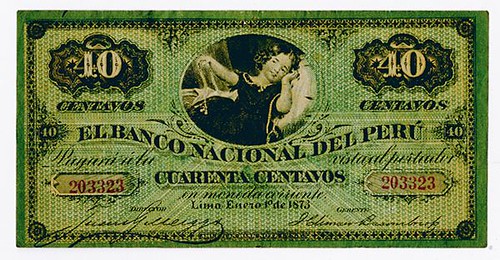
Lima, Peru. 1873, 40 Centavos, P-S302, Issued banknote, Black on green underprint, young girl reclining in middle, Signature titles: DIRECTOR and GERENTE. S/N 203323, Crisp VF condition with 2 small pin holes on the top middle margin and a small red ink area on the back top right margin, otherwise the note has sharp corners, firm paper body and bright colors that enhance this lovely little note. ABNC. Possibly one of the finest issued examples known of this note.
To read the complete lot description, see:
Banco Nacional Del Peru, 1873 Issued
Banknote. (https://auction.archivesinternational.com/Banco-Nacional-Del-Peru-1873-Issued-Banknote_i33142915)


Lots 404 and 530
Lot 404: 1848-51 Knickerbocker Bank Uncut Proof Sheet
Cayuga County, Genoa, NY. Uncut proof Sheet, $1-1-2-5, Haxby NY-935-G2-G2-G4-G6, All printed in black on india paper mounted on thin white card, the $1 notes are known as proofs and issued, the $2 note is not known as a proof, only issued and the $5 note is SENC. Zachary Taylor is on the $1 note with sailor and seated Knickerbocker, Workmen on the $2 note and men with horses on the $5 note, the sheet looks Uncirculated but the $5 note has a 1 inch tear at the bottom and the glue spots on the right side have been separated tearing the paper away from the design. The top 3 notes if cut carefully could come back Choice or Gem Uncirculated if desired. D&H, NY. Rare sheet.
To read the complete lot description, see:
Knickerbocker Bank, 1848-51
Uncut Proof Sheet of 4 Notes (https://auction.archivesinternational.com/Knickerbocker-Bank-1848-51-Uncut-Proof-Sheet-of-4-Notes_i33143074)
Lot 530: 1824 Fairman, Draper, Underwood & Co Proof Ad Sheet
Philadelphia. 1824, 12 1/2" x 15 1/2". With over sixty intaglio engraved vignettes, counters and end panels by one of the premier bank note companies of the 1820s. Near the top is an advertising bank note with an ornamental 5 near the center and Franklin and Washington at the sides. The reason for printing and distributing this type of sheet is made clear by the text on the bank note - "This Specimen of Work to prevent FORGERIES is respectfully submitted to the Banking Institutions of the UNITED STATES." Lightly pasted on to a contemporary ledger sheet that was used as a scrapbook page. Trimmed to the outside border, otherwise Choice VF.
Great banknote history, and a nice print for framing. -Editor
To read the complete lot description, see:
Fairman, Draper,
Underwood & Company 1824 Proof Advertising Sheet
(https://auction.archivesinternational.com/Fairman-Draper-Underwood-Company-1824-Proof-Advertising-Sheet_i33143178)
Lot 413: 1840 $20 Republic of Texas Banknote
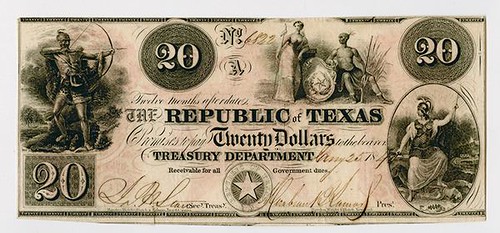
Texas. Republic of Texas 1840, $20, A-6, Indian shoots bow and arrow, dead bear, five-pointed star. Very Fine, neatly done slit cancels, nearly full borders. Vivid red-orange back. Well above average for the grade and type. RW&H.
Nice note, great history. Republic of texas notes are an interesting challenge to collect. -Editor
Lot 452: $5 Series 541 Military Payment Certificate

MPC, $5, P-M41, Plate 8,red-violet and green. Busts on front and back with victory wreaths. S/M F 02860714F, Very Fine to Choice VF with large even margins, bright colors and sharp corner.
A plain note, but avidly collected. -Editor
To read the complete lot description, see:
Military Payment
Certificate, $5, Series 541, ND (1958) M.P.C. Note
(https://auction.archivesinternational.com/Military-Payment-Certificate-5-Series-541-ND-1958-M-P-C-Note_i33143122)
Lot 754: 1876 Wells Fargo Mining Co. Stock Certificate

Virginia District, Storey County, Nevada. (Issued in San Francisco, CA). 100 Shares, I/U, Black on white with no underprints, Racing stage coach on top over title on bottom, Extremely rare with only 3 or 4 known. S/N 3205, Issued to J.H. Tufford and signed by D. McDonald as president, back endorsed by Tufford. VF condition with the certificate showing light wear with small multiple small pin holes on the left border area, a 4mm tear upper middle margin that is difficult to view and a small 3 by4 mm nick out of the lower left border area, still an extremely rare and attractive stock certificate. we sold a similar condition example in 2009 for $2100.
Great Western Americana item. -Editor
To read the complete lot description, see:
Wells Fargo Mining
Co., 1876 Stock Certificate with Racing Stage Coach.
(https://auction.archivesinternational.com/Wells-Fargo-Mining-Co-1876-Stock-Certificate-with-Racing-Stage-Coach_i33143402)

NUMISMATIC NUGGETS: MAY 12, 2019
Here's a selection of interesting or unusual items I came across in the marketplace this week. Tell us what you think of some of these. -Editor
MACEDON Roman Protectorate Tetradrachm

MACEDON. Roman Protectorate. 167-149 B.C. AR tetradrachm. 16.99 gm. 31 mm. Amphipolis mint. Diademed and draped bust of Artemis right, bow and quiver over shoulder, in the center of a Macedonian shield / Club, ΜΑΚΕΔΟΝΩΝ and monogram above, ΠΡΩΤΗΣ and two monograms below, all within oak wreath; thunderbolt to left. HGC 3.1, 1103. Near Extremely Fine; aesthetic style, sharply struck, with beautiful iridescent toning. Superb example of the type.
From the Davisson's E-Auction 30. -Editor
To read the complete lot description, see:
MACEDON. Roman Protectorate (https://davcoin.com/lot/e-auction-30-lot-13)
1838-O Liberty Seated Dime. No Stars


1838-O Liberty Seated Dime. No Stars. Fortin-102. Rarity-3. AU-55 (PCGS).
A lovely example of this brief type, from the first year of coinage operations at the New Orleans Mint.
Writing for the website seateddimevarieties.com, Gerry Fortin states that the 1838-O is, "A difficult date in AU or better with few Mint State examples known."
Coming up in the May 2019 Stack's Bowers Baltimore Auction. -Editor
To read the complete lot description, see:
1838-O Liberty Seated Dime. No Stars. Fortin-102. Rarity-3. AU-55 (PCGS).
(https://auctions.stacksbowers.com/lots/view/3-IARSJ
1841 Franklin Institute Medal
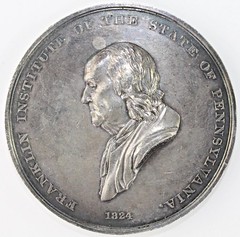

Description: BY GOBRECH AWARD 1844 SILVER. ESTIMATE: $775-$850
In the synchronicity department is this 1841 Franklin Institute medal which magically appeared on the market after we were just discussing these last week. -Editor
To read the complete lot description, see:
Lot 5: RARE FRANKLIN MEDAL
(https://www.invaluable.com/auction-lot/-1-c-2664709B04)
We're still hoping for readers assistance for Anthony Stuempfig in his search for the Franklin Institute silver medals awarded Charles H White. He adds that "the 1842 medal was sold at Millea Brothers Auction in the February 12-14, 2019 sale, Lot 3390." -Editor
To read the earlier E-Sylum article, see:
C H WHITE FRANKLIN INSTITUTE MEDAL SOUGHT
(https://www.coinbooks.org/v22/esylum_v22n18a13.html)
1881 Russian Tsarina Maria Feodorovna Medal
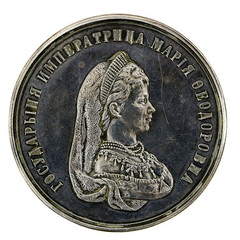

Description: Imperial Russian silver medal featuring the releif of Tsarina Maria Feodorovna on obverse and Cyrillic inscriptions on reverse: medal For Gooness and Success in Sciences. Issued in 1881. Weight: 0.9 oz., 26 g.
Dimensions: D: 1 3/4 in., (40 mm.)
It's just me I guess, but I think what caught my eye on this was the unusual arrangement on the reverse. The wide pedestal with the globe looks more like a tabletop, so why is the lady standing on a table? From the May 18, 2019 Helios Auctions sale in NYC. -Editor
To read the complete lot description, see:
Lot 224: SILVER RUSSIAN MEDAL WITH
TSARINA MARIA ROMANOV (https://www.invaluable.com/auction-lot/silver-russian-medal-with-tsarina-maria-romanov-224-c-aca45e8a25)
1886 Eutopia Dollar Sans Gold Center
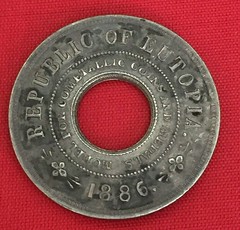

Did you know the U.S. has a holey dollar? At first glance this eBay lot from a seller in Hawaii looks just like the popular revalued coins of New South Wales and Prince Edward Island. But it's an example of Nicholas Veeder's "Eutopia Dollar", an 1886 proposal for a bimetallic currency that's missing its gold center plug. -Editor
To read the complete lot description, see:
1886 Eutopia Dollar SILVER / 206 ¼ GRS. Missing Gold Center
(https://www.ebay.com/itm/223509109439)

New South Wales Holey Dollar
To read the earlier E-Sylum article, see:
STOLEN HOLEY DOLLAR RECOVERED BY ANA
(https://www.coinbooks.org/esylum_v15n46a14.html)
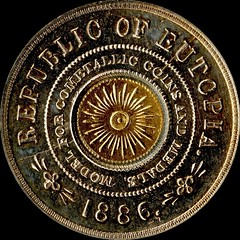

1886 Eutopia Dollar
To read the earlier E-Sylum article, see:
NUMISMATIC NUGGETS: APRIL 22, 2018 : 1886 Bi-Metallic Eutopia Dollar
(https://www.coinbooks.org/v21/esylum_v21n16a35.html)
A Long-Lasting Good Luck Token

I've seen plenty of Good Luck tokens in my day, but none made a boast as broad as this. So what happens when your run of good luck runs out? -Editor
LINCOLNSHIRE 4TH CENTURY ROMAN COIN HOARD
This BBC News article provides an update on the legal status of an unusual Roman coin hoard found in Lincolnshire in 2017. I don't believe we discussed this particular hoard earlier. -Editor

A hoard of early 4th Century Roman coins is believed to be the largest of its type ever discovered in Britain.
More than 3,000 copper alloy coins were found by two metal detectorists near the village of Rauceby, Lincolnshire, in July 2017.
Archaeologists say the coins were possibly buried as part of a ceremony, or commemoration.
The coins have now been declared as treasure following an inquest hearing in Lincoln.
Lincolnshire County Council archaeologist Adam Daubney, said the coins were found in a ceramic pot, buried in a large oval pit.
"What we found during the excavation suggests to me that the hoard was not put in the ground in secret, but rather was perhaps a ceremonial or votive offering."
"Unfortunately, we don't know for sure and might never know," he said.
"[But] what we do know is the coins date to the time Constantine was declared emperor in York (306 AD).
"Whether the two are related we don't know, but what is clear this is not your average hoard."
To read the complete article, see:
Lincolnshire Roman coin hoard 'is largest find in Britain'
(https://www.bbc.com/news/uk-england-lincolnshire-48215635)

ANGLO-SAXON TOMB YIELDS COINS
Only a couple of coins were found in this excavated Anglo-Saxon tomb, but the recovered artifacts are amazing. See the complete article online for a gallery of images. -Editor
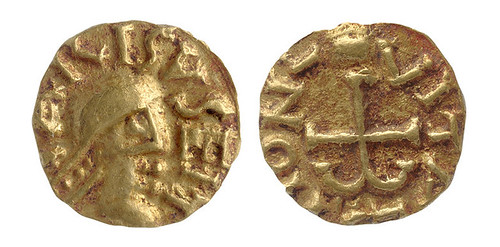
The researchers think the prince may have been buried with a gold coin in each hand, with one hand on his chest and the other lying by his side.
For 1,400 years, an underground burial chamber lay untouched in the British countryside, hiding its long-dead denizen and his royal secrets.
Then, in 2003, construction workers in the town of Prittlewell (about 40 miles from London) were expanding a roadway when they stumbled upon the remarkable tomb. Over time, researchers unearthed a lyre, gold coins, a golden belt buckle, and luxury items like drinking horns and bowls.
Unfortunately, the body of the occupant's body had long dissolved due to the acidic soil in this part of the UK; only tiny fragments of tooth enamel were left behind. The lack of human remains made it almost impossible for researchers to identify who the grave's owner was. But analysis of the other artifacts led archaeologists to believe that a Christian Anglo-Saxon prince had been entombed there.
 Now, after more than 15 years of excavation and restoration work, archaeologists from the Museum of London Archaeology (MOLA) have
discovered that the tomb may be the site of the earliest Christian royal burial in Britain.
Now, after more than 15 years of excavation and restoration work, archaeologists from the Museum of London Archaeology (MOLA) have
discovered that the tomb may be the site of the earliest Christian royal burial in Britain.
The researchers used radiocarbon dating to determine the age of the gold coins, and extrapolated from there.
"The dating has helped us to clarify who it might or might not be," Sophie Jackson, director of research and engagement at MOLA, told Business Insider. "Initially we thought this could have been King Saebert...but we know that he died in 616, and this man is likely to have been buried in 580s or 590s."
To read the complete article, see:
A warrior-prince's elaborate tomb found near London could be the British equivalent to King Tut, one expert says. Here's what was inside.
(https://www.businessinsider.com/anglo-saxon-warrior-prince-tomb-uk-king-tut-2019-5#the-researchers-think-the-prince-may-have-been-buried-with-a-gold-coin-in-each-hand-with-one-hand-on-his-chest-and-the-other-lying-by-his-side-7)
THE BOOK BAZARRE
AUSTRALIAN COIN FIND COULD BE FROM AFRICA
Australian archaeologists are working on the mystery of a coin of suspected African origin that could rewrite the history of the earliest visitation to that continent's coast. Here's an excerpt from a May 11, 2019 article in The Guardian. see the complete article online for additional images and much more information. -Editor
 It’s Anzac Day and the usually busy I-Med radiology clinic in Darwin is shiny and quiet, the public holiday giving the machines and their
operators a break from the usual broken bones, brain scans and ultrasounds.
It’s Anzac Day and the usually busy I-Med radiology clinic in Darwin is shiny and quiet, the public holiday giving the machines and their
operators a break from the usual broken bones, brain scans and ultrasounds.
But then an archaeologist and a historian turn up, bringing with them a curious patient whose identity is unknown, but who may be 1,000 years old and could rewrite Australian history.
The "patient" is a small copper coin found by archaeologist Mike Hermes on a field trip to the Wessel Islands, off north-east Arnhem Land, last year. He believes it to be a coin from Kilwa, more than 10,000km away in what is now known as Tanzania, dating from before the 15th century. Its surface is eroded, obscuring identifying features, but Hermes is confident.
"We’ve weighed and measured it, and it’s pretty much a dead ringer for a Kilwa coin," he says. "And if it is, well, that could change everything."
Hermes is part of the Past Masters, a group of historians, archaeologists, anthropologists, numismatists (coin experts), geochronologists and other experts who investigate historical anomalies. In the past six years they have mounted seven expeditions off the coast of northern Australia, finding previously undiscovered rock art, shipwrecks, stone tools, human remains and the Holy Grail, the Kilwa coin.
"We’re looking for the earliest visitation to the coast," historian Mike Owen says.
"This has never been explored. Our history is so Sydney-centric, the identity of the nation is built around that. And Sydney is a hell of a long way away from east Arnhem Land."
How the coins got to this part of the world is a much more perplexing mystery.
"Kilwa coins have only been found in Kilwa, the Arabian peninsula and the Wessel Islands," Hermes says. "It’s a puzzling distribution."

From left: A Kilwa coin bought online and a suspected Kilwa coin, from Africa pre-1400AD, found on the Wessel Islands in the Northern Territory.
I-Med Darwin’s chief radiographer, Jack Feeney, has been charged with identifying the coin – a rather unorthodox move by the Past Masters.
"You can use a special micro-CT scanner to detect the surface minutely, but there was no way we could get our hands on one of those, so this was the next best thing," Owen says.
Feeney carefully turns the thin, frail coin over in his hand, inspecting the jagged edges and pitted, uneven surface coated in grime.
"There is basically no hope for this one," he says. "I give it a 0% chance of working." "That’s what you said last time," Owen replies.
Last time was in March, when Owen first had the idea of using the CT scanner to identify another of Hermes’ finds from the English Company Islands, just east of the Wessels.
The scan was able to break through the layer of green crud on the copper coin to clearly reveal the VOC (Dutch East India Company) stamp and the date: 1790.
Although there were four VOC coins in Isenberg’s 1945 stash and they are not uncommon in Western Australia, this one was copper and struck in Utrecht rather than in Asia, making it the first corroborated find of a VOC coin of European manufacture in the Northern Territory.
Unfortunately, this time Feeney is right: after placing the ancient coin carefully on a pillow and running it through the CT scanner, only a black blob appears on his screen. Two vague ring-shapes can be seen on one edge, but these could just be divots rather than part of the coin’s design.
To read the complete article, see:
'It
could change everything': coin found off northern Australia may be from pre-1400 Africa
(https://www.theguardian.com/australia-news/2019/may/12/it-could-change-everything-coin-found-off-northern-australia-may-be-from-pre-1400-africa)
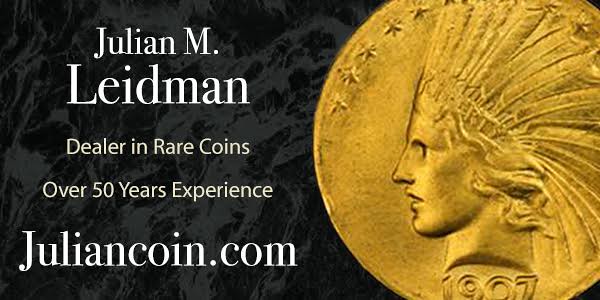
HOW MEDIEVAL AFRICANS PURIFIED GOLD FOR COINS
This Atlas Obscura article describes research into a process for purifying gold used by medieval Africans. -Editor

Coin mold fragments found in Tadmekka, Mali
WHEN SAM NIXON, AN ARCHAEOLOGIST with the British Museum, excavated ancient coin molds in Tadmekka, Mali, in 2005, it triggered a several-year exploration of how medieval Africans purified the gold they were using for their currency. Nixon had found little droplets of highly refined gold left over in the molds—which have been dated to the 11th century—as well as curious fragments of glass. Now scientists have recreated the advanced process behind the purification method they used then.
"This is the first time in the archaeological record that we saw glass being used to be able to refine gold," says Marc Walton, codirector of the Center for Scientific Studies in the Arts, a collaboration between Northwestern University and the Art Institute of Chicago. "The glass appeared to be material that was [actually] recycled glass materials … so it really shows the industriousness and creativity of the craftsmen, who understood the properties of gold and glass enough to [use them for] this process of refining gold." The recycled glass materials were remnants of broken vessels. Tadmekka was a town right in the middle of the trans-Saharan caravan route, so Nixon uncovered several types of material culture that had to do with trade, namely molds for "bald dinar," or coins that hadn’t been stamped with the name of a mint (or a 10th-century equivalent of one).
According to Walton, Europeans in the 10th and 11th centuries purified their gold through cupellation, a process in which lead is mixed with gold laced with impurities, and then heated in a furnace until the droplets of purer gold can be skimmed off. But in the case of medieval West Africans, "They were taking the ore and other raw materials from the river and mixing it with glass," says Walton. Since gold is inert, it doesn’t fully dissolve into melted glass, while impurities and other materials do, making this "a really novel way of using recycled glass material."
To read the complete article, see:
Medieval Africans Had a Unique Process for Purifying Gold With Glass
(https://www.atlasobscura.com/articles/medieval-african-gold)

DOUG WINTER REVIEWS FAIRMONT COLLECTION GOLD
In a May 10, 2019 blog post dealer Doug Winter discusses a hoard of U.S. gold coins ands its implications for the coin market. Here's an excerpt, but be sure to read the complete article online. Thanks to Martin Kaplan for passing this along. -Editor

Starting around May 2018, one of the most amazing hoards of United States gold coins I have ever seen started appearing for sale. Graded by PCGS and marketed by Stack’s Bowers, this massive group—likely containing tens of thousands++ of coins—consists of eagles and double eagles dated as early as 1850 and as late as the 1920s.
Known as the Fairmont Collection, these coins derive from an overseas bank and they likely have been off the market for 75 to 125+ years.
I have paid careful attention to these coins and have learned a tremendous amount about surface preservation, natural color, and rarity. I’d like to share some of my observations with you.
When I first learned about this group, I was simultaneously excited and scared. Excited because I knew I would be able to purchase quantities of virgin original coins; the exact sort of coins that I have been championing for many years. Scared because I was unaware of quantities and wondered if some currently rare issues would be ruined by an oversupply of coins.
Given my assumption that the majority of the really good 19th century coins have already been sold, I have been able to make an extremely important determination. Most of the No Motto eagles, Type One double eagles, and Type Two double eagles that I thought were really rare are. Dates that I scoffed at as faux-rarities have proven to be the traps that I always assumed they would be.
I wouldn’t have expected many rare date New Orleans double eagles to be in this hoard, and my hunch has proven to be correct. There have been no 1854-O, 1855-O, 1856-O, 1860-O, or 1861-O, and just a single example of the 1859-O and the 1879-O. The 1857-O has been represented by four coins sold (so far), with the finest of these grading MS60, while the 1858-O has been represented by three coins sold.
The single most expensive double eagle from this group sold to date was a PCGS/CAC AU53 1861-S Paquet Reverse which realized $96,000 as Stack’s Bowers 6/18: 195.
The quantity of the obviously common Type One double eagles in this hoard appears to be vast. As an examples, there are hundreds of nice EF and AU 1857-S (with original surfaces; a notable difference to the seawater coins seen most often). As recently as a few years ago, an EF45 1857-S double eagle was a $2,000 coin. Today, it is worth $1,500 and the coins which are available are—for the most part—exceptionally nice.
It is my belief that these coins, at today’s lower market-adjusted price levels, are absolutely fantastic values. In over 35 years of specializing in US gold coins, I have only seen a handful of hoard coins which were as nice as these Fairmont coins.
Typically, coins from overseas banks have dark black smudges on the high spots. I refer to this as "vault dirt" and while it doesn’t bother me, it certainly isn’t attractive and it is a turn-off to many collectors.
The Fairmont coins were stored differently and instead of getting dirty, they became nicely toned. The New Orleans coins have acquired a deep green-gold hue, the San Francisco coins show more of a reddish-gold coloration, and the Philadelphia coins have color which varies by decade with the older coins showing a darker green-gold hue while the newer coins show a lighter greenish shade.
To read the complete article, see:
One of the Coolest Hoards of US Gold Coins Ever Seen Has Entered the Market, and You (Probably) Don't Even Know About It...
(https://raregoldcoins.com/blog/2019/5/10/one-of-the-coolest-hoards-of-us-gold-coins-ever-seen-has-entered-the-market-and-you-probably-dont-even-know-about-it)

ON THE 1964 SPECIAL MINT SET
Martin Kaplan forwarded a promotional email via CoinWeek from GreatCollections, which offered a complete set of high-grade 1964 Special Mint Set coins in a sale closing earlier today. The 1965-1967 Special Mint Sets are common and well known, but there were also some precursor sets created by the Mint in 1964. -Editor
On the 1964 Special Mint Set
 All known 1964 SMS coins have a satiny surface, strong details, and a sharp rim. A lack of contact marks and sometimes die polishing marks
identify these coins as being specially struck. Furthermore, they do not display the mirror-like reflective surfaces of Proofs, yet the strike is
clearly stronger than either the 1964 Proof coinage or the SMS coinage of 1965, ’66, and ’67.
All known 1964 SMS coins have a satiny surface, strong details, and a sharp rim. A lack of contact marks and sometimes die polishing marks
identify these coins as being specially struck. Furthermore, they do not display the mirror-like reflective surfaces of Proofs, yet the strike is
clearly stronger than either the 1964 Proof coinage or the SMS coinage of 1965, ’66, and ’67.
The coins were unknown to the numismatic community at large until the 1990s. For many years, the first appearance at auction of pieces from a 1964 Special Mint Set was thought to be 1993, but researchers later discovered an unusual five-piece set of coins dated 1964 and struck at the Philadelphia Mint was offered at auction in 1991. The five Special Strikes in the ’91 sale were originally contained in the same plastic coin holder.
Numismatists believe that the 1964 Special Mint Sets may have belonged to former U.S. Mint Director Eva Adams, who was instrumental in bringing the Kennedy half dollar from concept to circulation in just a couple of months after the assassination of President John F. Kennedy on November 22, 1963.
The former Mint director died on August 23, 1991, and her estate was sold soon after. Coin dealer Lester Merkin is known to have bought some if not all of the coins from that sale.
For more information on the 1964 "Special Mint Set" Coins, see this PCGS article from 2008:
1964 "Special Mint Set" Coins
(https://www.pcgs.com/news/1964-special-mint-set-coins)
HAWKING JOKE FOOLS COIN COLLECTOR
Physicists aren't exactly known for their humor, but Stephen Hawking was, and I think he would have appreciated the outcome of this April Fool's prank from Physics World. -Editor
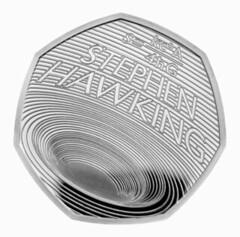 Do you remember our April Fool’s Day news story last month? In the spoof article, we pretended that the UK’s new 50p commemorative coin,
which contains Stephen Hawking’s famous equation for the entropy of a black hole, contained an error. We claimed that the mistake had been discovered
by 14-year-old French mathematical-physics prodigy "April Lapremiere". She found, we pretended, that Hawking had been out by a factor of two and that
the coin should have had a "2" on the denominator, rather than a "4". The coin, we lied, was now being withdrawn.
Do you remember our April Fool’s Day news story last month? In the spoof article, we pretended that the UK’s new 50p commemorative coin,
which contains Stephen Hawking’s famous equation for the entropy of a black hole, contained an error. We claimed that the mistake had been discovered
by 14-year-old French mathematical-physics prodigy "April Lapremiere". She found, we pretended, that Hawking had been out by a factor of two and that
the coin should have had a "2" on the denominator, rather than a "4". The coin, we lied, was now being withdrawn.
The joke should have been obvious as we laid it on pretty thick. Unfortunately, it went over the head of one reader – Jacob L (who is too embarrassed to have his full name revealed). A coin-collecting "warehouse grunt" with a keen interest in science, but no formal training, he e-mailed us this week to say he’d heard about the coin and had been interested in getting one for his personal collection. "But when I saw the article by April Lapremiere, detailing how the coin was recalled due to an error in the equation, I quickly bought two of the silver proof coins for $300," he wrote. "How I wish I knew French! I didn’t see the date, nor did I understand that it was a joke – I am no mathematician!"
Part of the problem for Jacob L was that we always "unpublish" our April Fool’s stories before 1 April is over to, er, avoid people getting the wrong end of the stick. But not having a way to track down the story, he later could not quite remember what we had written. And that’s when he decided to fork out for two of the coins, which might well have risen in price due to their future rarity (if the story had at all been true). Fortunately, Jacob L saw the funny side and is happy to share his cautionary tale with other readers. "If the story can make someone laugh (though at my expense), it is worth sharing," he signed off. "Next year, I’ll be a bit sharper come April first…"
To read the complete article, see:
Hawking joke
inspires coin collector, Chaos the lion has radiotherapy, how to coil a liquid jet
(https://physicsworld.com/a/hawking-joke-inspires-coin-collector-chaos-the-lion-has-radiotherapy-how-to-coil-a-liquid-jet/)
To read an earlier E-Sylum article, see:
NEW STEPHEN HAWKING 50-PENCE COIN
(https://www.coinbooks.org/v22/esylum_v22n12a28.html)

UAE COINS MARK OPENING OF SHARJAH MOSQUE
This report from the Emirates News Agency highlights two new coins issued on the opening of a new mosque. -Editor

The Central Bank of the UAE has issued two commemorative coins on the opening of Sharjah Mosque by H.H. Dr. Sheikh Sultan bin Muhammad Al Qasimi, Supreme Council Member and Ruler of Sharjah.
Designed and implemented by the Sharjah Islamic Bank, SIB, the first is a 9999 percent gold coin weighing 60g, with 60 mm diameter, on which main side the holy verse "The mosques of Allah are only to be maintained by those who believe in Allah and the Last Day" appears.
The other is a 9999 percent silver coin weighing 60g, with 60 mm diameter inscribed with the holy verse "The mosques of Allah are only to be maintained by those who believe in Allah and the Last Day and establish prayer and give Zakah and do not fear except Allah, for it is expected that those will be of the [rightly] guided".
Writing on both commemorative coins appear in Al Thuluth calligraphy.
To read the complete article, see:
Special coins issued on Sheikh
Sultan’s opening of Sharjah Mosque (https://www.gulftoday.ae/news/2019/05/10/special-coins-issued-on-sheikh-sultan-opening-of-sharjah-mosque)

2019 AMERICAN MEDAL OF THE YEAR: BREAKOUT
The American Medallic Sculpture Association has announced the winner of the 2019 American Medal of the Year award. -Editor

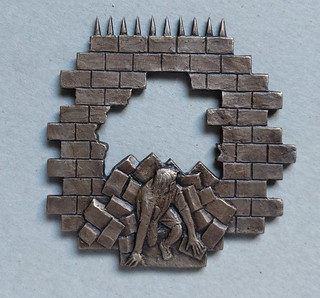
"Breakout" by Michael Meszaros
The American Medallic Sculpture Association (AMSA) is pleased to announce that the winner of the 2019 American Medal of the Year (AMY) award is "Breakout" by Michael Meszaros. Three additional medals were deemed worthy of Honorable Mention—"Hedy Lamarr," for the Jewish-American Hall of Fame, by Eugene Daub, "Robin Salmon, Curator of Sculpture at Brookgreen Gardens" by Dan Kraus, and "False Announcement" (that Harriet Tubman would replace Alexander Hamilton on $20 bills) by Art Ellis. For information about availability and prices, contact: Michael Meszaros at meszaros.sculptor@gmail.com, Eugene Daub at eugenedaub@cox.net, Dan Kraus at dan@KrausArt.com, and Art Ellis at art@artellis.net. A record number of 48 medals were submitted for the 2019 AMY award, according to jury chairperson, Mel Wacks.


"Hedy Lamarr" by Eugene Daub

"Robin Salmon, Curator of Sculpture at Brookgreen Gardens" by Dan Kraus

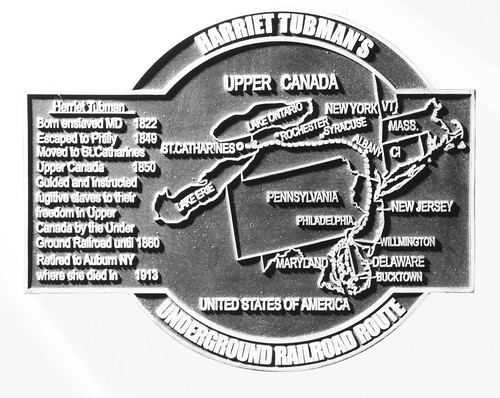
"False Announcement" by Art Ellis
All American medalists are welcome to participate in the AMY Award competition, as well as all AMSA members throughout the world. All of the entries can be viewed at
www.amsamedals.org. Medalists as well as collectors can join AMSA on their web site; dues are $40 in USA and Canada, $50 elsewhere.
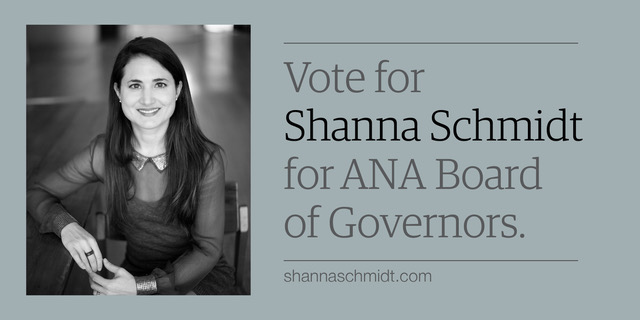
THERESIENSTADT GHETTO CURRENCY DONATED
Howard Berlin forwarded this Times of Israel article about a donation of Theresienstadt Ghetto currency to the National Library of Israel. Thanks. -Editor

Currency used in the Theresienstadt Ghetto was donated to the National Library of Israel.
The six bills featuring a Star of David and a sketch of Moses holding the Ten Commandments were received by the National Library days before Israel’s Yom Hashoah, or Holocaust Remembrance Day. They are worth a total of 263 Kronen, the currency of the ghetto, which was located in northwestern Czechoslovakia.
All ghetto residents were forced to convert their money and some property into the currency of the camp or ghetto in which they were imprisoned. If someone managed to escape, that person then had no way to purchase food or clothes.
The bills were donated by Ruth Brass of Britain, in honor of her father, the late Lionel Schalit, a prominent Zionist and community activist, and a leader in the European Maccabi Movement.
To read the complete article, see:
Arthur Shippee forwarded this article from the Jerusalem Post which included more images of the notes. Thanks. -Editor
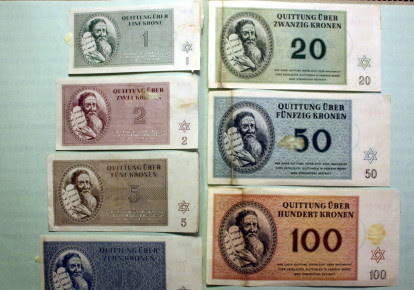
"It seems that the bank, the bills and the ‘wages’ received by many prisoners during imprisonment in the ghetto had an additional role: they gave the impression of ‘normalcy;’ of an orderly and routine everyday life that the Nazis indeed tried to present to the official representatives of the Red Cross who visited the Terezin Ghetto. The bills present documentation of the chilling reality in the days of the Holocaust: imaginary symbols of a ‘normalcy’ that never existed, under the shadow of persecution and eradication," according to National Library of Israel expert Dr. Stefan Litt.
To read the complete article, see:

TYPO DISCOVERED IN AUSTRALIAN BANKNOTE DESIGN
On Wednesday an Australian news service reported that a listener had discovered a typo in the design of the country's new $50 note. At least, that's where I first learned of this. But it wasn't long before E-Sylum readers spotted the story. -Editor
You had one responsibility.
The Reserve Bank was left scrambling for answers on Thursday morning after radio station Triple M posted a photo on Twitter sent in by an eagle-eyed listener.
The photo shows the RBA’s new $50 note under a magnifying glass and reveals an embarrassing typo in the reverse text, which features excerpts from Edith Cowan’s maiden speech to Western Australian Parliament.
News.com.au has confirmed the typo is indeed real.
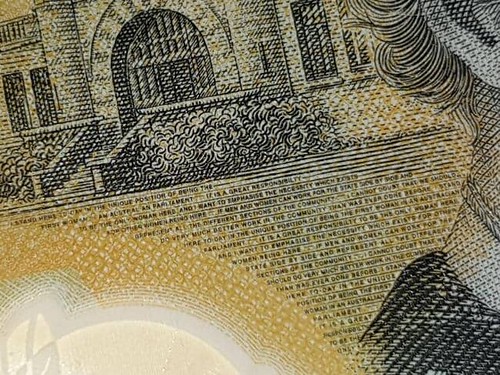
In the phrase "it is a great responsibility to be the only woman here", the word "responsibility" is misspelt as "responsibilty" — three times.
An RBA spokesman said, "The Reserve Bank of Australia is aware of it and the spelling will be corrected at the next print run."
He confirmed there had been "around 400 million" $50 banknotes printed with the error, with 46 million already in circulation.
"The next print run will commence around the middle of the year," he said.
"It is the first print run of the $50 banknote we have done since the error was detected. These banknotes will be ready to be released into circulation around the end of the year."
Rare currency dealer Jim Noble from Noble Numismatics said this was the first time in its history the RBA had pushed a typo through to circulation.
"They do misprint notes but they’re individual happenings rather than the whole production," Mr Noble said.
He added the RBA had "printed millions" so it was "not going to be rare".
To read the complete article, see:
It could well be that this was a true mistake, but banknote makers have long been known to insert deliberate "mistakes" and "typos" into currency designs as an anti-counterfeiting measure. With the fix there will now be two versions of the note in circulation and available to collectors for years to come. Those magnifying glasses will come in handy. -Editor
Pablo Hoffman writes:
Here’s the birth certificate of a collectible item.
Kavan Ratnatunga writes:
RBA should have just claimed it as a security feature which it maybe was as explained in that Frere-Jones that I sent and was posted on E-Sylum. I did get one of these Unc Au$50 notes in RBA Sydney in 2019 March.
To read the earlier E-Sylum article, see:
Thanks to Kavan, Pablo, Ron Guth, Katie de Silva, Dick Hanscom, Arthur Shippee, Len Augsburger and others for passing along various articles on the topic. -Editor


To read the complete article, see:
To read some other articles, see:
Getting the Spelling Right on 46 Million Bank Notes? It’s a Big Responsibilty (https://www.nytimes.com/2019/05/09/world/australia/australia-50-dollar-bill.html)
MONEY DIGGING ON MARTHA'S VINEYARD
This May 8, 2019 Martha's Vineyard Times article discusses old stories of buried treasure, real and imagined. Here's an excerpt - check out the complete article online. -Editor
In 1833, newspapers around the country reprinted a story from the New Bedford Gazette titled "Money Digging":
"A few days since, three young men on the south side of the Island of Martha’s Vineyard were engaged in laboring in a field which was once an orchard — two of them ploughing, and the other picking up stones at a distance. As the plough passed over a certain part of the land, the ploughshare started up two or three pieces of silver coin, which were hastily snatched up by the holder and put in his pocket. His companion observed him stoop and pick up something, and when the plough went over the spot again, seeing him repeat the movement, he desired to change situations with him.
"This was done, and he, too, reaped his crop; when each finding that the other was master of the secret, they proposed a manoeuvre to get rid of the third person, so that they could divide the spoil without his coming in for a share. They therefore declared it best to leave off work that forenoon, as it was nearly 12 o’clock, which was readily acquiesced in. What they obtained no one can exactly state — but it is believed not far from two or three thousand dollars were excavated. This was divided between the two; leaving [out] the man in the field with them."
As historian Charles Hine later noted, "the story got out in due time." The original article reported that the treasure had evidently been originally buried in a bag ("ascertained by pieces of cloth adhering to some of the coin"), but a footnote in an 1839 history book by William Dunlap claimed that it was "a pot, containing $1,800, ploughed up in a field upon Martha’s Vineyard," and attributed the loot to the pirate captain William Kidd.
Hines noted, "This is said to be the only case actually known where buried gold has been found" on the Island. But that was not for lack of trying. There were lots of stories of pirates and other mysterious strangers visiting the Island to stash their wealth. An 1811 article in the Boston Palladium reported that three men were sighted stealthily landing a longboat on the Island’s south shore at three o’clock in the morning. They spoke broken English and were thought to be Spaniards, and they carried five or six thousand dollars in coins. "Every appearance indicates them to be villains, who have perpetrated crimes of the deepest dye." They found passage to New Bedford, and vanished before they could be detained and questioned.
To read the complete article, see:
THE BOOK BAZARRE
LADY BURGLAR AND HER MYSTERIOUS TRUNK
We sometimes discuss stories of bank robberies and other crimes and scams that involve coins or paper money. This Atlas Obscura story mentions neither of those specifically, but it's an amazing tale of an outrageous lady grifter and her 15-year scam. -Editor
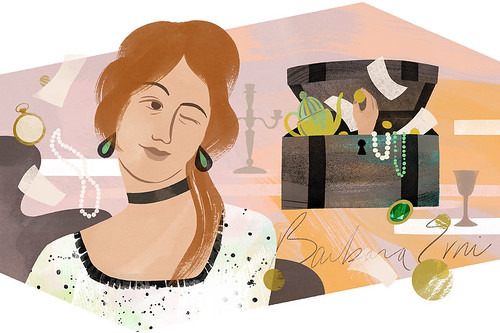
BARBARA ERNI’S SECRET WAS THAT she never had junk in her trunk. According to her, it held a potpourri of precious treasures. In reality, it held a tiny man, or possibly a large child.
Born to homeless parents in 1743 in the town of Feldkirch, Austria, which sits on the border between Switzerland and the tiny principality of Liechtenstein, Erni eventually made the best of her impoverished upbringing. Liechtensteinian legend has it that she was quite beautiful, boasting a mop of strawberry blond hair that earned her the nickname the "Golden Boo," writes Barbara Greene in her book Liechtenstein: Valley of Peace. Erni also possessed what townspeople saw as nearly superhuman strength that allowed her to tramp through the European countryside with an enormous satchel or treasure chest strapped to her back. She walked from inn to inn, where she would spend her nights.
Before turning in for bed, Erni would insist that her chest was far too valuable to leave out unattended in a bedroom with minimal security. Instead, she would demand that the innkeeper store her chest in their best, most secure room, perhaps even one that held valuables of their own. Innkeeper after hapless innkeeper fell for Erni’s tale, squirreling away the hefty trunk into a room that contained their own precious possessions, Greene writes. They would leave the room—which, of course, had no other exits—lock the door from the outside, and go to bed.
The next morning, in unlucky obliviousness, the innkeeper would move to unlock the door and realize several horrible things: that the door was unlocked and that Erni’s trunk had vanished, along with all of the innkeeper’s own valuables.
Erni’s real treasure, of course, was a tiny man or large child who would stow away in the trunk and emerge during the night after he had been locked away in the room full of valuables, writes Dan Davies in Lying for Money: How Legendary Frauds Reveal the Workings of Our World. He would then rifle through whatever seemed worth taking, toss it in the chest, and spirit away into the night with Erni.
The ruse was horribly, laughably simple, but Erni kept it up for nearly 15 years. It only fell apart when she became wealthy. In May 1784, the authorities finally apprehended Erni and her short accomplice in the town of Eschen, in northern Liechtenstein, and moved them to a holding cell in the capital city. During a court trial, Erni pled guilty to 17 separate burglaries. The two were sentenced to death by beheading, and on December 7, 1784, Erni lost much more than her goldenrod locks. On that day, she earned the dubious superlative of being the last person to be executed in Liechtenstein until the country abolished its death penalty in 1987.
To read the complete article, see:
LOOSE CHANGE: MAY 12, 2019
Here are some additional items I came across in the media this week that may be of interest. -Editor
ANS and EAC Honor Del Bland
CoinWeek recorded a video of the recent memorial service for researcher Del Bland at the 2019 convention of the Early American Coppers group. -Editor

Denis Loring Remembers Del Bland
On Friday, May 3, the American Numismatic Society (ANS) and more than 100 collectors from the Early American Coppers (EAC) met to celebrate and honor the life of Del Bland.
This CoinWeek video, recorded at the event, features comments of EAC President Bill Eckberg, ANS Librarian David Hill, numismatist Denis Loring, and Del’s sons, Larry and Gary.
To read the complete article (and watch the video, see:
Gaylen Dean Rust Indicted In Utah
This Salt Lake Tribune has the latest on the legal troubles of Gaylen Dean Rust, operator of Rust Rare Coin Inc. and son of Al Rust, author of the Mormon and Utah Coin and Currency. -Editor
A grand jury has indicted a Utah rare-coin dealer on six felony counts related to money laundering after he allegedly defrauded investors in a $200 million Ponzi scheme.
Gaylen Dean Rust, 59, is charged in the federal indictment with running a fake silver trading program — called Rust Rare Coin Inc. — where more than 500 people were allegedly conned into investing in precious metals. Investigators said they found an additional $30 million more than the judge first estimated was laundered when he froze Rust’s accounts in November.
To read the complete article, see:
To read the earlier E-Sylum article, see:
Mint Attorney Greg Weinman's Newspapers
US Mint Attorney Greg Weinman giving away old historic newspapers. Thanks to Len Augsburger of the Newman Numismatic Portal for the heads up. -Editor
To read the complete article, see:
Greg Weinman is on NNP video speaking about the 1933 $20 at:
PAPER MONEY QUILT
Who says you can't take it with you (to bed at night)? Jeff stark of Coin World posted these photos on Facebook of a paper money illustrated quilt sent to him by reader. Cozy! -Editor


a reader (Lynette Matter) sent these images of a paper money quilt she created for her dad. No real money was harmed in the making of this quilt. Thanks for sharing.
To read the complete article, see:
FEATURED WEB PAGE: WATERLOW BOOK
This week's Featured Web Page is from the site of banknote dealer Pam West.
In 2018 a Waterlow Sample book from c.1930s turned up in auction with an estimate of £100-£150. The book belonged to a Waterlow representative and it was probably taken home, put on the book shelf and never opened for almost ninety years. Over the next few pages you will find pictures we took with a tablet whilst viewing the lot. The book having never been opened was almost impossible to hold flat on the trestle table in a dark corner of the auction viewing room, i was leaning over Pete's shoulder, hence the pictures are at an angle.
The book was eventually sold for over £250,000 and has since been split up, the banknotes removed from the 71 pages and sold. The book had a white leather cover, the first two pages are complete banknotes, the majority of the balance are uniface proofs. The numbers on the top margin of the banknotes are to match obverse with reverse. We thank Spink for allowing us to publish the pictures we took. Please note that Spink own the copyright to the pictures.
www.britishnotes.co.uk/news_and_info/
picture_library/waterlowbook/index.php


